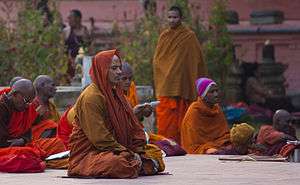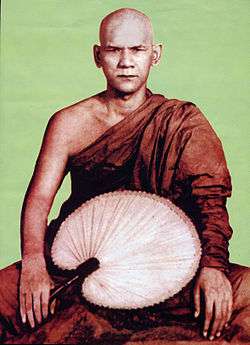Theravada
Theravāda (/ˌtɛrəˈvɑːdə/; Pāli, lit. "School of the Elders")[1][2] is the most commonly accepted name of Buddhism's oldest existing school.[1][2] The school's adherents, termed Theravādins, have preserved their version of Gautama Buddha's teaching in the Pāli Canon.[1][2] The Pāli Canon is the most complete Buddhist canon surviving in a classical Indian language, Pāli, which serves as the school's sacred language[2] and lingua franca.[3] For over a millennium, theravādins have endeavored to preserve the dhamma as recorded in their school's texts.[web 1] In contrast to Mahāyāna and Vajrayāna, Theravāda tends to be conservative in matters of doctrine and monastic discipline.[4]

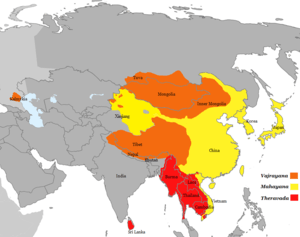
| Part of a series on |
| Theravāda Buddhism |
|---|
 |
|
|
Doctrine
|
|
Key Figures |
| Part of a series on |
| Buddhism |
|---|
 |
|
|
|
Modern Theravāda derives from the Mahāvihāra sect, a Sri Lankan branch of the Vibhajjavādins, a sub-sect of the Indian Sthavira Nikaya, which began to establish itself on the island from the 3rd century BCE onwards. It was in Sri Lanka that the Pāli Canon was written down and the school's commentary literature developed.
From Sri Lanka, the Theravāda Mahāvihāra tradition subsequently spread to the rest of Southeast Asia.[5] It is the dominant religion in Cambodia, Laos, Myanmar, Sri Lanka, and Thailand and is practiced by minorities in India, Bangladesh, China, Nepal, and Vietnam. The diaspora of all of these groups, as well as converts around the world, also practice Theravāda.
During the modern era, new developments have included Buddhist modernism, the Vipassana movement which reinvigorated Theravāda meditation practice [web 1] and the Thai Forest Tradition which reemphasized forest monasticism.
History
Origins
.jpg)
| Part of a series on |
| Early Buddhism |
|---|
 |
|
|
The name Theravāda comes[lower-alpha 1] from Sthāvirīya, one of the early Buddhist schools from which Theravādins trace their school's descent. The Sthavira nikāya emerged from the first schism in the Buddhist sangha (literally "Community"). At issue was its adherents' desire to add new Vinaya rules tightening monastic discipline, against the wishes of the majority Mahāsāṃghika.[6] According to its adherents' accounts, the Theravāda school derives from the Vibhajjavāda "doctrine of analysis" group,[7] which was a division of the Sthāvirīya.
Damien Keown denies that there is historical evidence of the Theravāda school's existence before around two centuries after the Great Schism, which occurred at the Third Council.[8] Theravadins' own accounts of their school's origins mention that it received the teachings that were agreed upon during the putative Third Buddhist council held around 250 BCE under the patronage of Indian Emperor Ashoka. These teachings were known as the Vibhajjavāda.[9] Emperor Ashoka is supposed to have assisted in purifying the sangha by expelling monks who declined to agree to the terms of Third Council.[10] The elder monk Moggaliputta-Tissa chaired the Third council and compiled the Kathavatthu ("Points of Controversy"), a refutation of various opposing views which is an important work in the Theravāda Abhidhamma.
Later, the Vibhajjavādins, in turn, is said to have split into four groups: the Mahīśāsaka, Kāśyapīya, Dharmaguptaka in the north, and the Tāmraparṇīya in South India. The Tambapaṇṇiya (later Mahāvihāravāsins), was established in Sri Lanka (at Anuradhapura) but active also in Andhra and other parts of South India (Vanavasa in modern Karnataka) and later across South-East Asia. Inscriptional evidence of this school has been found in Amaravati and Nagarjunakonda.[11] According to Buddhist scholar A. K. Warder, the Theravāda.
spread rapidly south from Avanti into Maharashtra and Andhra and down to the Chola country (Kanchi), as well as Sri Lanka. For some time they maintained themselves in Avanti as well as in their new territories, but gradually they tended to regroup themselves in the south, the Great Vihara (Mahavihara) in Anuradhapura, the ancient capital of Sri Lanka, becoming the main centre of their tradition, Kanchi a secondary center and the northern regions apparently relinquished to other schools.[12]
Transmission to Sri Lanka
.jpg)
Theravāda is said to be descended from the Tāmraparṇīya sect, which means "the Sri Lankan lineage". Missionaries sent abroad from India are said to have included Ashoka's son Mahinda (who studied under Moggaliputta-Tissa) and his daughter Sanghamitta. They were the mythical founders of Buddhism in Sri Lanka, a story which scholars suggest helps to legitimize Theravāda's claims of being the oldest and most authentic school.[10] According to the Mahavamsa chronicle, they arrived in Sri Lanka during the reign of Devanampiya Tissa of Anuradhapura (307–267 BCE) who converted to Buddhism and helped build the first Buddhist stupas. According to S. D. Bandaranayake:
The rapid spread of Buddhism and the emergence of an extensive organization of the sangha are closely linked with the secular authority of the central state ... There are no known artistic or architectural remains from this epoch except for the cave dwellings of the monks, reflecting the growth and spread of the new religion. The most distinctive features of this phase and virtually the only contemporary historical material, are the numerous Brahmi inscriptions associated with these caves. They record gifts to the sangha, significantly by householders and chiefs rather than by kings. The Buddhist religion itself does not seem to have established undisputed authority until the reigns of Dutthagamani and Vattagamani (c. mid-2nd century BCE to mid-1st century BCE) ...[13]
The first records of Buddha images come from the reign of the King Vasabha (65–109 CE), and after the 3rd century CE the historical record shows a growth of the worship of Buddha images as well as Bodhisattvas.[13] In the 7th century, the Chinese pilgrim monks Xuanzang and Yijing refer to the Buddhist schools in Sri Lanka as Shàngzuòbù (Chinese: 上座部), corresponding to the Sanskrit Sthavira nikāya and Pāli Thera Nikāya.[14] Yijing writes, "In Sri Lanka, the Sthavira school alone flourishes; the Mahasanghikas is expelled".[15]
The school has been using the name Theravāda for itself in a written form since at least the 4th century, about one thousand years after the Buddha's death, when the term appears in the Dīpavaṁsa.[16]
Between the reigns of Sena I (833–853) and Mahinda IV (956–972), the city of Anuradhapura saw a "colossal building effort" by various kings during a long period of peace and prosperity, the great part of the present architectural remains in this city date from this period.[17]
Development of the Pāli textual tradition
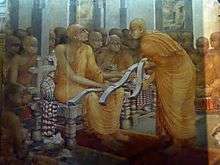
The Sri Lankan Buddhist Sangha initially preserved the Buddhist scriptures (the Tipitaka) orally as it had been traditionally done, however during the first century BCE, famine and wars led to the writing down of these scriptures. The Sri Lankan chronicle The Mahavamsa records: "Formerly clever monks preserved the text of the Canon and its commentaries orally, but then, when they saw the disastrous state of living beings, they came together and had it written down in books, that the doctrine might long survive."[18]
Richard Gombrich remarks that this is "the earliest record we have of Buddhist scriptures being committed to writing anywhere".[18] With few exceptions, surviving Theravādin Pāli texts derive from the Mahavihara (monastic complex) of Anuradhapura, the ancient Sri Lankan capital.[19]
Later developments included the formation and recording of the Theravāda commentary literature (Atthakatha). Theravāda tradition holds that a tradition of Indian commentaries on the scriptures existed even during Mahinda's early days.[20] Prior to the writing of the classic Theravādin Pāli commentaries, there were also various commentaries on the Tipitaka written in the Sinhala language, such as the Maha-atthakatha ("Great commentary"), the main commentary tradition of the Mahavihara monks.[21]
Of great importance to the commentary, tradition is the work of the great Theravāda scholastic Buddhaghosa (4th–5th century CE), who is responsible for most of the Theravāda commentarial literature that has survived (any older commentaries have been lost). Buddhaghosa wrote in Pāli, and after him, most Sri Lankan Buddhist scholastics did as well.[22] This allowed the Sri Lankan tradition to become more international through a lingua franca so as to converse with monks in India and later Southeast Asia.
Theravāda monks also produced other Pāli literature such as historical chronicles (e.g. Mahavamsa), hagiographies, practice manuals, summaries, textbooks, poetry, and Abhidhamma works such as the Abhidhammattha-sangaha and the Abhidhammavatara. Buddhaghosa's work on Abhidhamma and Buddhist practice outlined in works such as the Visuddhimagga and the Atthasalini are the most influential texts apart from the Pāli Canon in the Theravādin tradition. Other Theravādin Pāli commentators and writers include Dhammapala and Buddhadatta. Dhammapala wrote commentaries on the Pāli Canon texts, which Buddhaghosa had omitted, and also wrote a commentary called the Paramathamanjusa on Buddhaghosa's Visuddhimagga.
Sri Lankan Theravāda sects
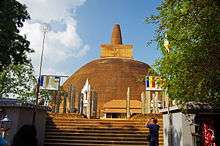
Over much of the early history of Buddhism in Sri Lanka, there were three subdivisions of Theravāda, consisting of the monks of the Mahāvihāra, Abhayagiri vihāra and Jetavana,[23] each of which were based in Anuradhapura. The Mahāvihāra was the first tradition to be established, while Abhayagiri Vihāra and Jetavana Vihāra were established by monks who had broken away from the Mahāvihāra tradition.[23] According to A. K. Warder, the Indian Mahīśāsaka sect also established itself in Sri Lanka alongside the Theravāda, into which they were later absorbed.[23] Northern regions of Sri Lanka also seem to have been ceded to sects from India at certain times.[23]
When the Chinese monk Faxian visited the island in the early 5th century, he noted 5000 monks at Abhayagiri, 3000 at the Mahāvihāra, and 2000 at the Cetiyapabbatavihāra.[24]
The Mahavihara ("Great Monastery") school became dominant in Sri Lanka at the beginning of the 2nd millennium CE and gradually spread through mainland Southeast Asia. It established itself in Myanmar in the late 11th century, in Thailand in the 13th and early 14th centuries, and in Cambodia and Laos by the end of the 14th century. Although Mahavihara never completely replaced other schools in Southeast Asia, it received special favor at most royal courts. This is due to the support it received from local elites, who exerted a very strong religious and social influence. [25]
Mahāyāna influence
.jpg)
Abhayagiri Theravādins maintained close relations with Indian Buddhists over the centuries, adopting many of the latter's teachings,[26] including many Mahāyāna elements, whereas Jetavana Theravādins adopted Mahāyāna to a lesser extent.[24][27] Xuanzang wrote of two major divisions of Theravāda in Sri Lanka, referring to the Abhayagiri tradition's adherents as "Mahāyāna Sthaviras" and those of the Mahāvihāra tradition as "Hīnayāna Sthaviras".[28] Xuanzang also wrote that the Mahāvihāravāsins reject Mahāyāna as heretical, whereas Abhayagirivihāravāsins study "both Hīnayāna and Mahāyāna".[24]
Abhayagiri was an influential university and center for the study of Mahayana from the reign of Gajabahu I until the 12th century.[29] It saw various important Buddhist scholars working in Sanskrit and Pāli. These include Upatissa (who wrote the Vimuttimagga), Kavicakravarti Ananda (authored the Saddhammopåyana), Aryadeva, Aryasura, and the tantric masters Jayabhadra, and Candramåli.[30]
Akira Hirakawa notes that the surviving Pāli commentaries (Aṭṭhakathā) of the Mahāvihāra school, when examined closely, also include a number of positions that agree with Mahāyāna teachings.[31] Kalupahana notes the same for the Visuddhimagga, the most important Theravāda commentary.[32]
It is known that in the 8th century, both Mahāyāna and the esoteric Vajrayāna form of Buddhism were being practised in Sri Lanka, and two Indian monks responsible for propagating Esoteric Buddhism in China, Vajrabodhi and Amoghavajra, visited the island during this time.[33] Abhayagiri Vihāra appears to have been a center for Theravādin Mahāyāna and Vajrayāna teachings.[34]
Reign of Parakramabahu I
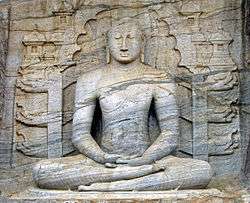
The trend of the Abhayagiri Vihara being a dominant sect changed in the 12th century, when the Mahāvihāra sect gained the political support of Parakramabahu I (1153–1186), who completely abolished the Abhayagiri and Jetavanin traditions.[35][36] The Theravāda monks of these two traditions were defrocked and given the choice of either returning to the laity permanently, or attempting reordination under the Mahāvihāra tradition as "novices" (sāmaṇera).[36][37] Richard Gombrich writes:[38]
Though the chronicle says that he reunited the Sangha, this expression glosses over the fact that what he did was to abolish the Abhayagiri and Jetavana Nikāyas. He laicized many monks from the Mahā Vihāra Nikāya, all the monks in the other two – and then allowed the better ones among the latter to become novices in the now 'unified' Sangha, into which they would have in due course to be reordained.
It seems that part of the reason for these radical moves was that Parakramabahu I saw the Sangha as being divided, corrupt and in need of reform, especially the Abhayagiri.[39] The Cūḷavaṁsa laments that at this time Theravāda monks had "turned away in their demeanor from one another and took delight in all kinds of strife".[40] This chronicle also claims that many monks in the Sri Lankan Sangha had even begun to marry and have children, behaving more like lay followers than monastics.[41] Parākramabāhu's chief monastic leader in these reforms was Mahathera Kassapa, an experienced monk well versed in the Scriptures and the Monastic discipline.[42]
Parakramabahu I is also known for rebuilding the ancient cities of Anuradhapura and Polonnaruwa, restoring Buddhist stupas and Viharas (monasteries).[43] He appointed a Sangharaja, or "King of the Sangha", a monk who would preside over the Sangha and its ordinations in Sri Lanka, assisted by two deputies.[38] The reign of Parakkamabāhu also saw a flowering of Theravāda scholasticism with the work of prominent Sri Lankan scholars such as Anuruddha, Sāriputta Thera, Mahākassapa Thera of Dimbulagala Vihara and Moggallana Thera.[43] They worked on compiling of subcommentaries on the Tipitaka, texts on grammar, summaries and textbooks on Abhidhamma and Vinaya such as the influential Abhidhammattha-sangaha of Anuruddha.
Spread to Southeast Asia
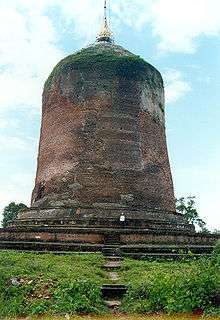
According to the Mahavamsa, a Sri Lankan chronicle, after the conclusion of the Third Buddhist council, a mission was sent to Suvarnabhumi, led by two monks, Sona and Uttara.[44] Scholarly opinions differ as to where exactly this land of Suvarnabhumi was located, but it is generally believed to have been located somewhere in the area of Lower Burma, Thailand, the Malay Peninsula, or Sumatra.
From the 8th to the 12th centuries Indian Buddhist traditions arrived in Southeast Asia via the Bay of Bengal from India.[45] Before the 12th century, the areas of Thailand, Myanmar, Laos, and Cambodia were dominated by Buddhist sects from India, and included the teachings of Mahāyāna Buddhism.[46][47] In the 7th century, Yijing noted in his travels that in these areas, all major sects of Indian Buddhism flourished.[46]
After the 12th century Buddhism mostly disappeared from India and Theravāda Buddhism came to dominate Southeast Asia.[48]
Myanmar
Though there are some early accounts that have been interpreted as Theravāda in Myanmar, the surviving records show that most Burmese Buddhism incorporated Mahāyāna, and used Sanskrit rather than Pāli.[47][49][50] After the decline of Buddhism in India, missions of monks from Sri Lanka gradually converted Burmese Buddhism to Theravāda, and in the next two centuries also brought Theravāda Buddhism to the areas of Thailand, Laos, and Cambodia, where it supplanted previous forms of Buddhism.[51]
The Mon and Pyu were among the earliest people to inhabit Myanmar. The oldest surviving Buddhist texts in the Pāli language come from Pyu city-state of Sri Ksetra. The text, which is dated from the mid 5th to mid 6th century, is written on twenty-leaf manuscript of solid gold.[52] Peter Skilling concludes that there is firm evidence for the dominant presence of Theravāda in "the Irrawaddy and Chao Phraya basins, from about the 5th century CE onwards", though he adds that evidence shows that Mahāyāna was also present.[53]
The Burmese slowly became Theravādin as they came into contact with and conquered the Pyu and Mon civilizations beginning in the 11th century during the reign of the Bamar king Anawrahta (1044–1077) of the Pagan Kingdom. He acquired the Pāli scriptures in a war against the Mon as well as from Sri Lanka and build stupas and monasteries at his capital of Bagan.[54] Various invasions of Burma by neighboring states and the Mongol invasions of Burma (13th century) damaged the Burmese sangha and Theravāda had to be reintroduced several times into the country from Sri Lanka and Thailand.
Cambodia and Thailand
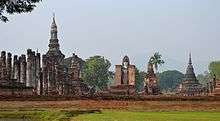
The Khmer Empire (802–1431) centered in Cambodia was initially dominated by Hinduism; Hindu ceremonies and rituals were performed by Brahmins, usually only held among ruling elites of the king's family, nobles, and the ruling class. Tantric Mahayana Buddhism was also a prominent faith, promoted by Buddhist emperors such as Jayavarman VII (1181–1215) who rejected the Hindu gods and presented himself as a Bodhisattva King.
During his reign, King Jayavarman VII (c. 1181–1218) sent his son Tamalinda to Sri Lanka to be ordained as a Buddhist monk and study Theravāda Buddhism according to the Pāli scriptural traditions in the Mahavihara monastery. Tamalinda then returned to Cambodia and promoted Buddhist traditions according to the Theravāda training he had received, galvanizing and energizing the long-standing Theravāda presence, which had existed throughout the Angkor empire for centuries. During the 13th and 14th centuries, Theravādin monks from Sri Lanka continued introducing orthodox Theravāda Buddhism, which eventually became the dominant faith among all classes.[55] Monastics replaced members of the local priestly classes, purveying religion, education, culture, and social service for Cambodian villages. This change in Cambodian Buddhism led to high levels of literacy among Cambodians.[56]
In Thailand, Theravāda existed alongside Mahayana and other religious sects before the rise of Sukhothai Kingdom.[57] During the reign of King Ram Khamhaeng (c. 1237/1247–1298) Theravāda was made the main state religion and promoted by the king as the orthodox form of Thai Buddhism.
Despite its success in Southeast Asia, Theravāda Buddhism in China has generally been limited to areas bordering Theravāda countries.
Tantric and esoteric innovations
During the pre-modern era, Southeast Asian Buddhism included numerous elements which could be called tantric and esoteric (such as the use of mantras and yantras in elaborate rituals). The French scholar François Bizot has called this "Tantric Theravāda", and his textual studies show that it was a major tradition in Cambodia and Thailand.[58] Some of these practices are still prevalent in Cambodia and Laos today.
Later Theravāda textual materials show new and somewhat unorthodox developments in theory and practice. These developments include what has been called the "Yogāvacara tradition" associated with the Sinhala Yogāvacara's manual (c. 16th to 17th centuries) and also Esoteric Theravāda also known as Borān kammaṭṭhāna ('ancient practices'). These traditions include new practices and ideas which are not included in classical orthodox Theravāda works like the Visuddhimagga, such as the use of mantras (such as Araham), the practice of magical formulas, complex rituals and complex visualization exercises.[59][60] These practices were particularly prominent in the Siam Nikaya before the modernist reforms of King Rama IV (1851–1868) as well as in Sri Lanka.
Modernisation and spread to the West

In the 19th century began a process of mutual influence of both Asian Buddhists and Hinduists, and a Western audience interested in ancient wisdom. Theravāda was also influenced by this process, which lead to Buddhist modernism; especially Helena Blavatsky and Henry Steel Olcott, founders of the Theosophical Society, had a profound role in this process in Sri Lanka. Simultaneously, vipassana-meditation was re-invented, and in Theravāda countries a lay vipassana practice developed. This took a high flight in East Asia from the 1950s onwards with the vipassana-movement, and from the 1970s also in the west, with western students who popularized vipassana-meditation in the west,[61] giving way to the development and popularisation of mindfulness-practice.[62]
Reaction against Western colonialism
Buddhist revivalism has also reacted against changes in Buddhism caused by colonialist regimes. Western colonialists and Christian missionaries deliberately imposed a particular type of Christian monasticism on Buddhist clergy in Sri Lanka and colonies in Southeast Asia, restricting monks' activities to individual purification and temple ministries.[63] Prior to British colonial control, monks in both Sri Lanka and Burma had been responsible for the education of the children of lay people, and had produced large bodies of literature. After the British takeover, Buddhist temples were strictly administered and were only permitted to use their funds on strictly religious activities. Christian ministers were given control of the education system and their pay became state funding for missions.[64]
Foreign, especially British, rule had an enervating effect on the Sangha.[65] According to Walpola Rahula, Christian missionaries displaced and appropriated the educational, social, and welfare activities of the monks, and inculcated a permanent shift in views regarding the proper position of monks in society through their institutional influence upon the elite.[65] Many monks in post-colonial times have dedicated themselves to undoing these changes.[66] Movements intending to restore Buddhism's place in society have developed in both Sri Lanka and Myanmar.[67]
One consequence of the reaction against Western colonialism has been a modernization of Theravāda Buddhism: Western elements have been incorporated, and meditation practice has opened to a lay audience. Modernized forms of Theravādan practice have spread to the West.[61]
Sri Lanka
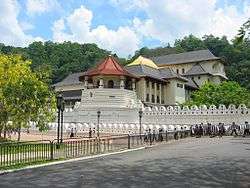
In Sri Lanka, Theravādins were looking to Western culture for means to revitalize their own tradition.[68] Christian missionaries were threatening the Buddhist culture.[69] As a reaction to this, Theravādins became active in spreading Buddhism and debating Christians. They were aided by the Theosophical Society, whose members were dedicated to searching for wisdom within ancient sources. Anagarika Dharmapala was one of the Theravāda leaders with whom the Theosophists sided. Dharmapala reached out to the middle classes, offering them religious practice and a religious identity, which were used to withstand the British cultural influence. As a result of Dharmapala's efforts, lay practitioners started to practise meditation and study Buddhism, which had been reserved specifically for the monks.[70]
The Pali Text Society's translation and publication of the Pāli Canon improved its availability to lay audiences in the both the West and the East. The Theosophical Society promoted western-lay interest in Theravāda Buddhism, which endured until the beginning of the 20th century. Interest rose again during the 1970s, leading to a surge of Westerners searching for enlightenment, and republication of the Pāli Canon, first in print, and later on the Internet.
Myanmar

An influential modernist figure in Myanmar Buddhism was king Mindon Min (1808–1878). He promoted the Fifth Buddhist council (1871) and inscribed the Pali canon into marble slabs, creating the world's largest book in 1868. During his reign, various reformist sects came into being such as the Dwaya and the Shwegyin, who advocated a stricter monastic conduct than the mainstream Thudhamma tradition.[71] During colonial Burma, there were constant tensions between Christian missionaries and Buddhist monks (which included one of the first Western convert monks, U Dhammaloka). After independence, Myanmar was also the place for the Sixth Buddhist council (Vesak 1954 to Vesak 1956), which was attended by monks from eight Theravāda nations to recite the Pāli Canon. The Council synthesized a new redaction of the Pāli texts ultimately transcribed into several native scripts. In Myanmar, this Chaṭṭha Saṅgīti Piṭaka (Sixth council Pitaka) was published by the government in 40 volumes.
Modern vipassanā meditation practice was re-invented in Myanmar in the 19th century. The "New Burmese method" was developed by U Nārada and popularized by his student Mahasi Sayadaw and Nyanaponika Thera. Another prominent teacher is Bhikkhu Bodhi, a student of Nyanaponika. The New Burmese Method strongly emphasizes vipassanā over samatha. It is regarded by traditionalists as a simplification of traditional Buddhist meditation techniques, suitable not only for monks but also for lay practitioners. The method has been popularized in the West by teachers of the vipassana movement such as Joseph Goldstein, Jack Kornfield, Tara Brach, Gil Fronsdal and Sharon Salzberg.
The Ledi lineage begins with Ledi Sayadaw.[72] S. N. Goenka is a well-known teacher in the Ledi-lineage. According to S. N. Goenka, vipassana techniques are essentially nonsectarian in character, and have universal application. Meditation centers teaching the vipassanā popularized by S. N. Goenka exist now in India, Asia, North and South America, Europe, Australia, Middle East and Africa.[73]
Thailand and Cambodia
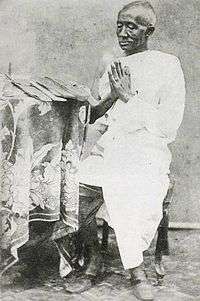
With the coming to power in 1851 of King Mongkut, who had been a monk himself for twenty-seven years, the sangha, like the kingdom, became steadily more centralized and hierarchical, and its links to the state more institutionalized. Mongkut was a distinguished scholar of Pāli Buddhist scripture.[74] Moreover, at that time the immigration of numbers of monks from Burma was introducing the more rigorous discipline characteristic of the Mon sangha. Influenced by the Mon and guided by his own understanding of the Tipitaka, Mongkut began a reform movement that later became the basis for the Dhammayuttika Nikaya. Mongkut advocated a stricter adherence to the Vinaya (monastic discipline). He also emphasized study of the scriptures, and rationalism.[75] His son King Chulalongkorn created a national structure for Buddhist monastics and established a nationwide system of monastic education.[75]
In the early 1900s, Thailand's Ajahn Sao Kantasīlo and his student, Mun Bhuridatta, led the Thai Forest Tradition revival movement. In the 20th century notable practitioners included Ajahn Thate, Ajahn Maha Bua and Ajahn Chah.[76] It was later spread globally by Ajahn Mun's students including Ajahn Thate, Ajahn Maha Bua and Ajahn Chah and several Western disciples, among whom the most senior is Luang Por Ajahn Sumedho.
Modern Buddhism in Cambodia was strongly influenced by Thai Buddhism. The Dhammayuttika Nikaya was introduced into the country during the reign of King Norodom (1834–1904) and benefited from royal patronage.[77] The rule of the Khmer Rouge effectively destroyed Cambodia's Buddhist institutions by disrobing and killing monks and destroying temples.[78] After the end of the regime the Sangha was re-established. An important figure of modern Cambodian Theravāda is Maha Ghosananda who promoted a form of engaged Buddhism to effect social change.
Modern developments
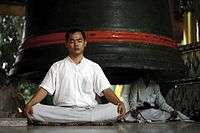
The following modern trends or movements have been identified.[79][web 3]
- Modernism: attempts to adapt to the modern world and adopt some of its ideas; including, among other things:
- Green movement, ecological work.[80]
- Syncretism with other Buddhist as well as Hindu (in Sri Lanka, India, Nepal, Bali and Thailand) traditions
- Universal inclusivity
- Reformism: attempts to restore a supposed earlier, ideal state of Buddhism; includes in particular the adoption of Western scholars' theories of original Buddhism (in recent times the "Western scholarly interpretation of Buddhism" is the official Buddhism prevailing in Sri Lanka and Thailand).[81]
- Ultimatism: tendency to concentrate on advanced teachings such as the Four Noble Truths at the expense of more elementary ones
- Neotraditionalism; includes among other things
- Revival of ritualism
- Remythologization
- Social and political action, including engaged Buddhism, protesting and participating in election politics.[82]
- Devotional religiosity
- Reaction to Buddhist nationalism
- Renewal of forest monks
- Revival of meditation practice (by monks and laypersons), emphasizing meditation centers and retreats. Ledi Sayadaw (1846–1923) is particular important in this regard.
- Revival of the Theravāda bhikkhuni (female monastic) lineage (not recognized by some male sangha authorities).
- Convert Buddhism in Western countries, establishment of Western monastic orders (especially the Thai forest tradition) and development of Pāli scholarship in Western languages.
Texts
Pāli Canon
According to Kate Crosby, for Theravāda, the Pāli Canon is "the highest authority on what constitutes the Dhamma (the truth or teaching of the Buddha) and the organization of the Sangha (the community of monks and nuns)."[83]
The Sutta and Vinaya portion of the Tipitaka shows considerable overlap in content to the Agamas, the parallel collections used by non-Theravāda schools in India which are preserved in Chinese and partially in Sanskrit, Prakrit, and Tibetan, and the various non-Theravāda Vinayas. On this basis, both these sets of texts are generally believed to be the oldest and most authoritative texts on pre-sectarian Buddhism by scholars. It is also believed that much of the Pāli Canon, which is still used in Theravādin communities, was transmitted to Sri Lanka during the reign of Ashoka. After being orally transmitted (as was the custom for religious texts in those days) for some centuries, the texts were finally committed to writing in the last century BCE, at what Theravādins usually reckon to be the fourth council, in Sri Lanka. Theravāda is one of the first Buddhist schools to commit its complete Canon to writing.[84]
Much of the material in the Canon is not specifically "Theravādan", but the collection of teachings that this school's adherents preserved from the early, non-sectarian body of teachings. According to Peter Harvey:
The Theravādans, then, may have added texts to the Canon for some time, but they do not appear to have tampered with what they already had from an earlier period.[85]
The Pāli Tipitaka consists of three parts: the Vinaya Pitaka, Sutta Pitaka and Abhidhamma Pitaka. Of these, the Abhidhamma Pitaka is believed to be a later addition to the first two pitakas, which, in the opinion of many scholars, were the only two pitakas at the time of the First Buddhist Council. The Pāli Abhidhamma was not recognized outside the Theravāda school.
The Tipitaka is composed of 45 volumes in the Thai edition, 40 in the Burmese and 58 in the Sinhala, and a full set of the Tipitaka is usually kept in its own (medium-sized) cupboard.
Vinaya (monastic discipline) and Abhidhamma
According to Kate Crosby:
Since much Sutta material overlaps with that found in the Sūtra collections of other Buddhist traditions, it is the Vinaya (monastic discipline) and Abhidhamma that are the most distinctive formal aspects of Theravāda Buddhism, unique to Theravāda.[86]
The Vibhajjavāda school (‘the analysts’), the branch of the Sthāvira school from which Theravāda is derived, differed from other early Buddhist schools on a variety of teachings.[87] The differences resulted from the systematization of the Buddhist teachings, which was preserved in the Abhidharmas of the various schools.[88] The unique doctrinal positions of the Theravāda school are expounded in what is known as the Abhidhamma-piṭaka, as well as in the later Pāli commentaries (Aṭṭha-kathā) and sub-commentaries (ṭīkā). Because of the size of this canonical and commentarial literature the Pāli tradition developed a tradition of handbooks and doctrinal summaries, the most influential of which are the Visuddhimagga and the Abhidhammaṭṭhasaṅgaha.[89]
The Pāli Abhidhamma is "a restatement of the doctrine of the Buddha in strictly formalized language ... assumed to constitute a consistent system of philosophy".[90] Its aim is not the empirical verification of Buddhist teachings,[90] but "to set forth the correct interpretation of the Buddha's statements in the Sutra to restate his 'system' with perfect accuracy".[90] Because Abhidhamma focuses on analyzing the internal lived experience of beings and the intentional structure of consciousness, the system has often been compared to a kind of phenomenological psychology by numerous scholars such as Nyanaponika, Bhikkhu Bodhi and Alexander Piatigorsky.[91]
The Theravāda school has traditionally held the doctrinal position that the canonical Abhidhamma Pitaka was actually taught by the Buddha himself.[92] Modern scholarship in contrast, has generally held that the Abhidhamma texts date from the 3rd century BCE.[93] However some scholars, such as Frauwallner, also hold that the early Abhidhamma texts developed out of exegetical and catechetical work which made use of doctrinal lists which can be seen in the suttas, called matikas.[94][95]
Non-canonical literature
In the 4th or 5th century Buddhaghosa Thera wrote the first Pāli commentaries to much of the Tipitaka (which were based on much older manuscripts, mostly in old Sinhala), including commentaries on the Nikayas and his commentary on the Vinaya, the Samantapāsādikā. Buddhaghosa wrote as part of the Mahavihara tradition in Sri Lanka, a tradition which came to dominate the island and all of Theravāda after the 12th century.[96]
After him many other monks wrote various texts, which have become part of Theravāda's heritage. These texts do not have the same authority as the Tipitaka does, though Buddhaghosas Visuddhimagga is a cornerstone of the commentarial tradition.
Another important genre of Theravādin literature is shorter handbooks and summaries, which serve as introductions and study guides for the larger commentarial works. Two of the more influential summaries are Sariputta Thera's Pālimuttakavinayavinicchayasaṅgaha, a summary of Buddhaghosa's Vinaya commentary and Anuruddha's Abhidhammaṭṭhasaṅgaha (Manual of Abhidhamma).[89]
The Pāli texts and language are symbolically and ritually important for many Theravādins; however, most people are likely to access Buddhist teachings though vernacular literature, oral teachings, sermons, art and performance as well as films and Internet media.[97] According to Kate Crosby, "there is a far greater volume of Theravāda literature in vernacular languages than in Pāli."[98]
An important genre of Theravādin literature, in both Pāli and vernacular languages are the Jataka tales, stories of the Buddha's past lives. They are very popular among all classes and are rendered in a wide variety of media formats, from cartoons to high literature. The Vessantara Jātaka is one of the most popular of these.[99]
Theravāda Buddhists consider much of what is found in the Chinese and Tibetan Mahāyāna scriptural collections to be apocryphal, meaning that they are not authentic words of the Buddha.[100]
Doctrine
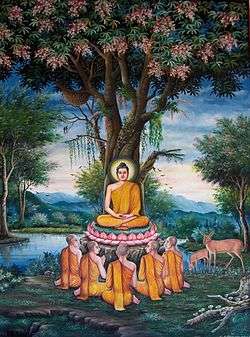
Core teachings
The core of Theravāda Buddhist doctrine is contained in the Pāli Canon, the only complete collection of Early Buddhist texts surviving in a classical Indic language.[101] These ideas are shared by other Early Buddhist schools as well as by Mahayana traditions. They include central concepts such as:
- The Middle Way
- The four noble truths
- The Noble Eightfold Path
- Three marks of existence (impermanence, suffering, not-self)
- Five aggregates (of a person)
- Dependent arising
- Karma and rebirth
- Jhana (meditative absorption)
- The bodhipakkhiyādhammā (37 factors conducive to awakening)
- Kleshas and asavas (mental defilements)
- Avidyā (Ignorance)
- Nirvana (the goal of Buddhism, the complete end of suffering)
Abhidhamma philosophy
Theravāda has developed a systematic exposition of the Buddhist doctrine called the Theravāda Abhidhamma. In the Pāli Nikayas, the Buddha teaches through a method in which experience is explained using various conceptual groupings of physical and mental processes, which are called dhammas. This method is called an analytical method. Examples of lists of dhammas taught by the Buddha include the twelve sense 'spheres' or ayatanas, the five aggregates or khanda and the eighteen elements of cognition or dhatus.[102]
Theravāda traditionally promotes itself as the Vibhajjavāda "teaching of analysis" and as the heirs to the Buddha's analytical method. Expanding this model, Theravāda Abhidhamma scholasticism concerned itself with analyzing "ultimate truth" (paramattha-sacca) which it sees as being composed of all possible dhammas and their relationships. The central theory of the Pāli Abhidhamma is thus known as the "Dhamma theory".[103][104] "Dhamma" has been translated as "factors" (Collett Cox), "psychic characteristics" (Bronkhorst), "psycho-physical events" (Noa Ronkin) and "phenomena" (Nyanaponika Thera).[105][3]
According to Y. Karunadasa, a dhamma, which can be translated as "a 'principle' or 'element' (dharma)", is "those items that result when the process of analysis is taken to its ultimate limits".[103] However, this does not mean that they have an independent existence, for it is "only for the purposes of description" that they are postulated.[106] Noa Ronkin defines dhammas as "the constituents of sentient experience; the irreducible ‘building blocks’ that make up one's world, albeit they are not static mental contents and certainly not substances."[107] Thus, while in Theravāda Abhidhamma, dhammas are the ultimate constituents of experience, they are not seen as substances, essences or independent particulars, since they are empty (suñña) of a self (attā) and conditioned.[108] This is spelled out in the Patisambhidhamagga, which states that dhammas are empty of svabhava (sabhavena suññam).[109]
According to Ronkin, the canonical Pāli Abhidhamma remains pragmatic and psychological, and "does not take much interest in ontology" in contrast with the Sarvastivada tradition. Paul Williams also notes that the Abhidhamma remains focused on the practicalities of insight meditation and leaves ontology "relatively unexplored".[110] Ronkin does note however that later Theravāda sub-commentaries (ṭīkā) do show a doctrinal shift towards ontological realism from the earlier epistemic and practical concerns.[111]
The Theravāda Abhidhamma holds that there is a total of 82 possible types of dhammas, 81 of these are conditioned (sankhata), while one is unconditioned, which is nibbana. The 81 conditioned dhammas are divided into three broad categories, consciousness (citta), associated mentality (cetasika) and materiality, or physical phenomena (rupa).[112] Since no dhamma exists independently, every single dhamma of consciousness, known as a citta, arises associated (sampayutta) with at least seven mental factors (cetasikas).[113] In Abhidhamma, all awareness events are thus seen as being characterized by intentionality and never exist in isolation.[112] Much of Abhidhamma philosophy deals with categorizing the different consciousnesses and their accompanying mental factors as well as their conditioned relationships (paccaya).[113]
Doctrinal differences with other Buddhist schools
The doctrinal stances of the Theravāda school vis-a-vis other early Buddhist schools is presented in the Pāli text known as the Kathāvatthu, "Points of Controversy", which said to have been compiled by the scholar Moggaliputta-Tissa (c. 327–247 BCE). It includes several philosophical and soteriological matters.
Traditionally, the Theravāda school generally holds some of the following key doctrinal positions:[114]
- Theravādins traditionally believe that an awakened arahant (lit. worthy one) has an "incorruptible nature" and are thus morally perfect.[115]
- On the Philosophy of time, the Theravāda tradition holds to philosophical presentism, the view that only present moment dhammas exist, against the eternalist view of the Sarvāstivādin tradition which held that dhammas exist in all three times – past, present, future.
- Like other schools, they reject the Pudgalavada doctrine of the pudgala ("person") as being more than a conceptual designation.
- The Theravāda rejected the view of the Lokottaravada schools which held that the all acts done by the Buddha (including all speech, defecation and urination, etc) were supramundane or transcendental.[116] They also reject the docetic view which holds that the Buddha's body was a mere "transformation" or magical creation of a transcendental being.[117]
- Theravāda rejects the view that there is an intermediate state (antarabhāva) between rebirths, they hold that rebirth happens instantaneously (in one mind moment).[118]
- Theravāda traditionally holds that insight into the four noble truths happens in one moment, rather than gradually, as was held by Sarvastivada.
- Theravāda traditionally defends the idea that the Buddha himself taught the Abhidhamma Pitaka.[119] Though this has been questioned by some moderns in light of modern scholarship.
- Theravāda rejects the Mahayana sutras as Buddhavacana (word of the Buddha), and do not study or see these texts as reliable sources. They further reject the view that the Tipitaka is incomplete and that Mahayana texts are somehow more advanced.[120]
Modern trends
The modern era saw new developments in Theravāda scholarship due to the influence of Western thought. As Donald K Swearer writes:
Although monastic education is still grounded in the study of Buddhist texts, doctrine, and the Pali language, the curricula of monastic colleges and universities also reflect subject matter and disciplines associated with Western education.[121]
Buddhist modernist trends can be traced to figures like Anagarika Dhammapala and King Mongkut.[122] They promoted a form of Buddhism that was compatible with rationalism and science, and opposed to superstition. Walpola Rahula’s, What the Buddha Taught is seen by scholars as an introduction to modernist Buddhist thought and this book continues to be widely used in universities.[121] Another phenomenon is Buddhist philosophers educated in the West, such as K. N. Jayatilleke (a student of Wittgenstein) and Hammalawa Saddhatissa, going on to write modern works on Buddhist philosophy (Early Buddhist Theory of Knowledge, 1963 and Buddhist Ethics, 1987 respectively).
The colonial clash with Christianity also led to debates (such as the Panadura debate) and doctrinal works written in defense of Buddhism or attacking Christian ideas, such as Gunapala Dharmasiri's A Buddhist critique of the Christian concept of God (1988).
Another development has been modern literature promoting socially Engaged Buddhism and Buddhist economics from thinkers such as Buddhadasa, Sulak Sivaraksa, Prayudh Payutto, Neville Karunatilake and Padmasiri de Silva.
Modern scholarship by Western Buddhist monks such as Nyanaponika Thera was also a new development in the modern era.
Practice (paṭipatti)
.svg.png)
Textual basis
In the Pāli Canon, the path (magga) or way (patipada) of Buddhist practice is described in various ways, one of the most widely used frameworks in Theravāda is the Noble Eightfold Path:
The Blessed One said, "Now what, monks, is the Noble Eightfold Path? Right view, right resolve, right speech, right action, right livelihood, right effort, right mindfulness, right concentration."[web 4]
The Noble Eightfold Path can also be summarized as the Three Noble Disciplines of sīla (moral conduct or discipline), samādhi (meditation or concentration) and paññā (understanding or wisdom).[web 5][123][web 6]
Theravāda orthodoxy takes the seven stages of purification as outlined in the Visuddhimagga as the basic outline of the path to be followed. The Visuddhimagga, a Sinhala Theravāda doctrinal summa written in the fifth century by Buddhaghosa, became the orthodox account of the Theravāda path to liberation in Sri Lanka after the 12th century and this influence spread to other Theravāda nations.[96] It gives the sequence of seven purifications, in three sections:
- The first section (part 1) explains the rules of discipline, and the method for finding a correct temple to practice, or how to meet a good teacher.
- The second section (part 2) describes samatha (calming) practice, object by object (see kammaṭṭhāna for the list of the forty traditional objects). It mentions different stages of samādhi.
- The third section (parts 3–7) is a description of the five khandhas, ayatanas, the Four Noble Truths, dependent origination, and the practise of vipassanā (insight) through the development of wisdom. It emphasizes different forms of knowledge emerging because of the practice. This part shows a great analytical effort specific to Buddhist philosophy.
This basic outline is based on the threefold discipline. The emphasis is on understanding the three marks of existence, which removes ignorance. Understanding destroys the ten fetters and leads to nibbana.
Theravādins believe that every individual is personally responsible for achieving his or her own self-awakening and liberation, each being responsible for his or her own kamma (actions and consequences). Applying knowledge acquired through direct experience and personal realization is more heavily emphasized than beliefs about the nature of reality as revealed by the Buddha.
Moral conduct
Sīla, meaning moral conduct, is mainly defined as right speech, right action, and right livelihood. It is primarily understood through the doctrine of kamma. In Theravāda, one's previous intentional actions strongly influence one's present experience. Whatever intended actions are carried out will have future consequences, whether in this life or subsequent lives.[124] Intention is central to the idea of kamma. Actions done with good intentions, even if they have bad results, will not have negative kammic consequences.
Several sets of precepts or moral trainings (sikkhāpada) guide right action. After taking refuge in the three jewels, lay Theravādins traditionally take the five precepts (whether for life or for a limited time) in the presence of a monastic.[125] Laypeople also sometimes take an extended set of eight precepts, which includes chastity during special occasions such as religious holidays.
Performing good deeds is another important feature of Theravāda ethics. Doing so is said to make "merit" (puñña), which results in a better rebirth. The "ten wholesome actions" is a common list of good deeds:[126]
- Generosity (dāna); This typically involves providing monks with “the four requisites”; food, clothing, shelter, and medicine; however, giving to the lay needy is also considered dāna.
- Moral conduct (sīla); Keeping the five precepts and generally refraining from doing harm.
- Meditation (bhāvanā).
- Transferring merit; doing good deeds in the name of someone who has died or in the name of all beings.
- Rejoicing in merit of good deeds done by others, this is common in communal activities.
- Rendering service to others; looking after others.
- Honoring others; showing appropriate deference, particularly to the Buddha, Dhamma and Sangha, and to seniors and parents. Usually done by placing the hands together in Añjali Mudrā, and sometimes bowing.
- Preaching Dhamma; the gift of Dhamma is seen as the highest gift.
- Listening to Dhamma
- Having correct views; mainly the four noble truths and the three marks of existence.
Meditation
Meditation (Pāli: Bhāvanā, literally "causing to become" or cultivation) means the positive cultivation of one's mind.
Forms
Theravāda Buddhist meditation practice varies considerably in technique and objects.[127] Currently, there are also various traditions of Theravāda meditation practice, such as the Burmese Vipassana tradition, the Thai Forest tradition, the esoteric Borān kammaṭṭhāna ('ancient practices'), the Burmese Weikza tradition, Dhammakaya meditation and the Western Insight Meditation movement.
Theravāda Buddhist meditation practices or bhavanas (cultivations) are categorized into two broad categories: Samatha bhavana (calming), and Vipassanā bhavana (investigation, insight).[web 7] Originally these referred to effects or qualities of meditation, but after the time of Buddhaghosa, they also referred to two distinct meditation types or paths (yāna).[128][129][web 8]
Samatha ("calm") consists of meditation techniques in which the mind is focused on a single object, thought, or mantra, leading to samadhi'. In traditional Theravāda it is considered to be the base for vipassanā ("insght"). In the Theravāda-tradition, as early as the Pāli Nikayas, the four jhānas are regarded as a samatha-practice. The eighth and final step of the Eightfold Path, Right Samadhi, is often defined as the four jhanas.[130] In the Pāli Nikayas, Jhānas are described as preceding the awakening insight of the Buddha, which turned him into an awakened being.[web 9] Yet the interpretation of jhana as single-pointed concentration and calm may be a later re-interpretation in which the original aim of jhana was lost.[131]
Vipassana ("insight", "clear seeing") refers to practices that aim to develop an inner understanding or knowledge of the nature of phenomena (dhammas), especially the characteristics of dukkha, anatta and anicca, which are seen as being universally applicable to all constructed phenomena (sankhata-dhammas). Vipassana is also described as insight into dependent origination, the five aggregates, the sense spheres and the four noble truths.[132][129] It is the primary focus of the modernist Burmese Vipassana movement. In western countries it is complemented with the four divine abidings, the development of loving-kindness and compassion.[133][134]
Vipassana practice begins with the preparatory stage, the practice of sila, morality, giving up worldly thoughts and desires.[135][136] The practitioner then engages in anapanasati, mindfulness of breathing, which is described in the Satipatthana Sutta as going into the forest and sitting beneath a tree and then simply to watch the breath. If the breath is long, to notice that the breath is long, if the breath is short, to notice that the breath is short.[137][138] In the "New Burmese Method" the practitioner pays attention to any arising mental or physical phenomenon, engaging in vitaka, noting or naming physical and mental phenomena ("breathing, breathing"), without engaging the phenomenon with further conceptual thinking.[139][140] By noticing the arising of physical and mental phenomena the meditator becomes aware of how sense impressions arise from the contact between the senses and physical and mental phenomena,[139] as described in the five skandhas and paṭiccasamuppāda. The practitioner also becomes aware of the perpetual changes involved in breathing, and the arising and passing away of mindfulness.[141] This noticing is accompanied by reflections on causation and other Buddhist teachings, leading to insight into dukkha, anatta, and anicca.[142][141] When the three characteristics have been comprehended, reflection subdues and the process of noticing accelerates, noting phenomena in general without necessarily naming them.[143][144][145]
According to Vajiranāṇa Mahathera, writing from a traditional and text-based point of view, in the Pāli Canon whether one begins the practice by way of samatha or by way of vipassanā is generally seen as depending on one's temperament. According to Vajiranāṇa Mahathera, it is generally held that there are two kinds of individuals. Those of a passionate disposition (or those who enter the path by faith) attain Arahatship through vipassanā preceded by samatha. Those of a skeptical disposition (or those who enter by way of wisdom or the intellect) achieve it through samatha preceded by vipassanā.[129]
Aims of meditation

Traditionally, the ultimate goal of the practice is to achieve mundane and supramundane wisdom. Mundane wisdom is the insight in the three marks of existence.[web 8] The development of this insight leads to four supramundane paths and fruits, these experiences consist a direct apprehension of Nibbana.[web 10] Supramundane (lokuttara) wisdom refers to that which transcends the world of samsara.[web 10]
Apart from nibbana, there are various reasons why traditional Theravāda Buddhism advocates meditation, including a good rebirth, supranormal powers, combating fear and preventing danger. Recent modernist Theravādins have tended to focus on the psychological benefits and psychological well being.[147]
Four stages of enlightenment
According to Theravāda doctrine, liberation is attained in four stages of enlightenment:[web 11][web 8]
- Stream-Enterers: Those who have destroyed the first three fetters (false view of Self, doubt, and clinging to rites and rituals);[web 12][web 13]
- Once-Returners: Those who have destroyed the first three fetters and have lessened the fetters of lust and hatred;
- Non-Returners: Those who have destroyed the five lower fetters, which bind beings to the world of the senses;[148]
- Arahants: Those who have reached Enlightenment – realized Nibbana, and have reached the quality of deathlessness –are free from all defilements. Their ignorance, craving and attachments have ended.[148]
Historical development and sources
The practice of Theravāda meditation can be traced back to the 5th century exegete Buddhaghosa, who systematized the classic Theravāda meditation, dividing them into samatha and vipassana types and listing 40 different forms (known as "kammaṭṭhānas", "workplaces") in his magnum opus, the Visuddhimagga.[149][150] This text has remained central for the study and practice of Theravāda meditation. Buddhaghosa's commentary on the Satipatthana sutta ("Bases of mindfulness discourse"), as well as the source text itself, are also another important source for meditation in this tradition.[151] Buddhaghosa's work drew heavily on the Pali suttas as well as the Pali Abhidhamma. Kate Crosby notes that Buddhaghosa's work also "explicitly refers to the contemporaneous existence of secret meditation manuals but not to their content."[151]
Regarding post Visuddhimagga Theravāda meditation, according to Kate Crosby,
In the period between the Visuddhimagga and the present, there have been numerous meditation texts, both manuals and descriptive treatises. Many of the texts found in manuscript collections relate to meditation, some on a single, simple subject such as the recollection of the qualities of the Buddha, others more complex. Little research has been done to assess their variety. One difficulty is that meditation manuals as such are often in a mixture of a classical language, that is, Pali, and a vernacular that may or may not be a currently used language. Also, actual manuals often contain prompts or reminders rather than an in-depth explanation. In recent years it has emerged that there is still extant a relatively high number of manuals and related texts pertaining to a system of meditation called – among other things – borān kammaṭṭhāna or yogāvacara. Its core text, the Mūla-kammaṭṭhāna “original, fundamental or basic meditation practice,” circulated under a number of different titles, or without a title, throughout the Tai–Lao–Khmer and Sri Lankan Buddhist worlds. Some versions of this text are simple lists of kammaṭṭhāna and from that perspective look entirely in accord with the Visuddhimagga or Theravada Abhidhamma texts. Other versions contain extensive narratives, explanations of symbolism, and of the somatic locations involved in the practice that make it clear that we are dealing with techniques of practice not described in the Canon or Visuddhimagga.[151]
According to Crosby, the esoteric borān kammaṭṭhāna or yogāvacara meditation tradition was the dominant form of meditation in the Theravāda world during the 18th century, and may date as far back as the 16th century. Crosby notes that this tradition of meditation involved a rich collection of symbols, somatic methods and visualizations which included "the physical internalisation or manifestation of aspects of the Theravada path by incorporating them at points in the body between the nostril and navel."[152] In spite of the novel elements in this meditation tradition, close study of borān kammaṭṭhāna texts reveals that they are closely connected to Theravada Abhidhamma and the works of Buddhaghosa.[153] Modernist reforms which emphasized Pali Canon study, a shift in state support to other traditions and modern wars in Indochina led to this tradition's decline, and it now only survives in a few Cambodian and Thai temples.[154]
During the 19th and 20th centuries, the Theravāda world saw a modernist revival and reinvention of meditation practice, as exemplified by the Burmese Vipassana movement.[155][156] According to Buswell vipassana, "appears to have fallen out of practice" by the 10th century, due to the belief that Buddhism had degenerated, and that liberation was no longer attainable until the coming of Maitreya.[157] The practice was revived in Myanmar (Burma) in the 18th century by Medawi (1728–1816) and by later figures such as Ledi Sayadaw and Mahāsī Sayadaw during the 19th and 20th centuries. These Burmese figures re-invented vipassana-meditation and developed simplified meditation techniques, based on the Satipatthana sutta, the Visuddhimagga, and other texts, emphasizing satipatthana and bare insight.[155][156] These techniques were globally popularized by the Vipassana movement in the second half of the 20th century.
Similar revival movements developed in Thailand, such as the Thai forest tradition and Dhammakaya meditation. These traditions are influenced by the older borān kammaṭṭhāna forms.[158] Thailand and Cambodia also saw attempts to preserve and revive the ancient "borān kammaṭṭhāna" tradition of meditation.[159] In Sri Lanka, the new Buddhist traditions of the Amarapura and Rāmañña Nikāyas developed their own meditation forms based on the Pali Suttas, the Visuddhimagga, and other manuals, while borān kammaṭṭhāna mostly disappeared by the end of the 19th century.[160]
Though the Vipassana movement has popularised meditation both in traditional Theravāda countries among the laity, and in western countries, "meditation plays a minor if not negligible role in the lives of the majority of Theravāda monks."[161][162][web 1] Meditation is especially popular laypersons,[163] especially during special religious holidays or in their old age, when they have more free time to spend at the temple.[162] Buddhist modernists tend to present Buddhism as rational and scientific, and this has also affected how Vipassana meditation has been taught and presented. This has led in some quarters to a playing down of older non-empirical elements of Theravāda, associated with 'superstition'.[164] Strains of older, traditional Theravāda meditation known as "borān kammaṭṭhāna" still exist, but this tradition has mostly been eclipsed by the Buddhist modernist meditation movements.[165]
Other practices
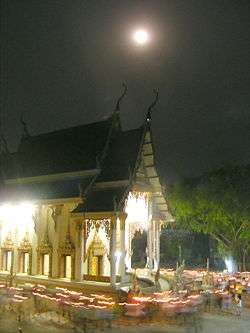
Laypersons and monks also perform various types of religious practices daily or during Buddhist holidays. One of these is keeping a Buddhist shrine with a picture or statue of the Buddha for devotional practice in one's home, mirroring the larger shrines at temples.[166] It is common to offer candles, incense, flowers and other objects to these shrine.[166] Gestures of respect are also done in front of Buddha images and shrines, mainly the respectful salutation with the hands (añjalikamma), and the five-limb prostration (pañc'anga-vandana).[166]
Buddhist forms of chanting is also widely practiced by both monks and laypersons, who may recite famous phrases such as the taking of refuge, the metta sutta and the mangala sutta in front of their shrine. Chanting may also be part of the practice of recollection (anussati), which refers to contemplating various topics such as the sublime qualities of the Buddha, Dhamma and Sangha or the five subjects for daily recollection.[166] This may be done as part of a daily puja ritual.
Another important religious practice for the devout is the keeping of special religious holidays known as Uposatha which are based on a lunar calendar. Laypersons commonly take the eight precepts while visiting a temple or monastery and commit to focusing on Buddhist practice for the day.[166]
Study (ganthadhura) of the Buddhist texts and listening to Dhamma talks by monks or teachers are also important practices.
Lay and monastic life
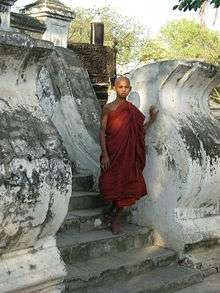
Distinction between lay and monastic life
Traditionally, Theravāda Buddhism has observed a distinction between the practices suitable for a lay person and the practices undertaken by ordained monks (in ancient times, there was a separate body of practices for nuns). While the possibility of significant attainment by laymen is not entirely disregarded by the Theravāda, it generally occupies a position of less prominence than in the Mahāyāna and Vajrayāna traditions, with monastic life being hailed as a superior method of achieving Nirvana.[167] The view that Theravāda, unlike other Buddhist schools, is primarily a monastic tradition has, however, been disputed.
Some Western scholars have erroneously tried to claim that Mahāyāna is primarily a religion for laymen and Theravāda is a primarily monastic religion. Both Mahāyāna and Theravāda have as their foundation strong monastic communities, which are almost identical in their regulations. Schools of Mahāyāna Buddhism without monastic communities of fully ordained monks and nuns are relatively recent and atypical developments, usually based on cultural and historical considerations rather than differences in fundamental doctrine. Both Mahāyāna and Theravāda also provided a clear and important place for lay followers.
— Ron Epstein, "Clearing Up Some Misconceptions about Buddhism"[168]
This distinction between ordained monks and laypeople – as well as the distinction between those practices advocated by the Pāli Canon, and the folk religious elements embraced by many monks – have motivated some scholars to consider Theravāda Buddhism to be composed of multiple separate traditions, overlapping though still distinct. Most prominently, the anthropologist Melford Spiro in his work Buddhism and Society separated Burmese Theravāda into three groups: Apotropaic Buddhism (concerned with providing protection from evil spirits), Kammatic Buddhism (concerned with making merit for a future birth), and Nibbanic Buddhism (concerned with attaining the liberation of Nirvana, as described in the Tipitaka). He stresses that all three are firmly rooted in the Pāli Canon. These categories are not accepted by all scholars, and are usually considered non-exclusive by those who employ them.
The role of lay people has traditionally been primarily occupied with activities that are commonly termed merit-making (falling under Spiro's category of kammatic Buddhism). Merit-making activities include offering food and other basic necessities to monks, making donations to temples and monasteries, burning incense or lighting candles before images of the Buddha, and chanting protective or merit-making verses from the Pali Canon. Some lay practitioners have always chosen to take a more active role in religious affairs, while still maintaining their lay status. Dedicated lay men and women sometimes act as trustees or custodians for their temples, taking part in the financial planning and management of the temple. Others may volunteer significant time in tending to the mundane needs of local monks (by cooking, cleaning, maintaining temple facilities, etc.). Lay activities have traditionally not extended to study of the Pāli scriptures, nor the practice of meditation, though in the 20th century these areas have become more accessible to the lay community, especially in Thailand.

A number of senior monastics in the Thai Forest Tradition, including Buddhadasa, Ajahn Maha Bua, Ajahn Plien Panyapatipo, Ajahn Pasanno, and Ajahn Jayasaro, have begun teaching meditation retreats outside of the monastery for lay disciples. Ajahn Sumedho, a disciple of Ajahn Chah, founded the Amaravati Buddhist Monastery in Hertfordshire, which has a retreat center specifically for lay retreats. Sumedho extended this to Harnham in Northumberland as Aruna Ratanagiri under the present guidance of Ajahn Munindo, another disciple of Ajahn Chah.
Lay devotee
_1.jpg)
In Pāli the word for a male lay devotee is Upasaka and a female devotee is Upasika. One of the duties of the lay followers, as taught by the Buddha, is to look after the needs of the monk/nuns. They are to see that the monk/nuns do not suffer from lack of the four requisites: food, clothing, shelter and medicine. As neither monks nor nuns are allowed to have an occupation, they depend entirely on the laity for their sustenance. In return for this charity, they are expected to lead exemplary lives.
In Myanmar and Thailand, the monastery was and is still regarded as a seat of learning. In fact today about half of the primary schools in Thailand are located in monasteries. Religious rituals and ceremonies held in a monastery are always accompanied by social activities. In times of crisis, it is to the monks that people bring their problems for counsel. Traditionally, a ranking monk will deliver a sermon four times a month: when the moon waxes and wanes and the day before the new and full moons. The laity also have a chance to learn meditation from the monks during these times.
It is also possible for a lay disciple to become enlightened. As Bhikkhu Bodhi notes, "The Suttas and commentaries do record a few cases of lay disciples attaining the final goal of Nirvana. However, such disciples either attain Arahantship on the brink of death or enter the monastic order soon after their attainment. They do not continue to dwell at home as Arahant householders, for dwelling at home is incompatible with the state of one who has severed all craving."[169]
In the modern era, it is now common for lay disciples to practice meditation, attend lay meditation centers and even aim for awakening. The impetus for this trend began in Myanmar and was supported by prime minister U Nu who himself established the International Meditation Center (IMC) in Yangon.[170] Modern lay teachers such as U Ba Khin (who was also the Accountant General of the Union of Burma) promoted meditation as part of a laypersons daily routine.[170] According to Donald K Swearer, another development in modern Theravāda is "the formation of lay Buddhist associations that have partially assumed the social service responsibilities formerly associated with the monastery".[170] These include social service and activist organizations such as the Young Men's Buddhist Association of Colombo, the All Ceylon Buddhist Congress, the Sarvodaya Shramadana of A. T. Ariyaratne, the NGO's founded by Sulak Sivaraksa such as Santi Pracha.[171]
Monastic vocation
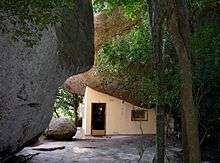
Theravāda sources dating back to medieval Sri Lanka (2nd century BCE to 10th century CE) such as the Mahavamsa show that monastic roles in the tradition were often seen as being in a polarity between urban monks (Sinhala: khaamawaasii, Pāli: gamavasi) on one end and rural forest monks (Sinhala: aranyawaasii, Pali: araññavasi, nagaravasi, also known as Tapassin) on the other.[172] The ascetic focused monks were known by the names Pamsukulikas (rag robe wearers) and Araññikas (forest dwellers).[173]
The Mahavamsa mentions forest monks associated with the Mahavihara. The Pāli Dhammapada Commentary mentions another split based on the "duty of study" and the "duty of contemplation".[174] This second division has traditionally been seen as corresponding with the city – forest split, with the city monks focusing on the vocation of books (ganthadhura) or learning (pariyatti) while the forest monks leaning more towards meditation (vipassanadhura) and practice (patipatti).[175] However this opposition is not consistent, and urban monasteries have often promoted meditation while forest communities have also produced excellent scholars, such as the Island Hermitage of Nyanatiloka.[175]
Scholar monks generally undertake the path of studying and preserving Theravāda's Pāli literature.[176] Forest monks tend to be the minority among Theravāda sanghas and also tend to focus on asceticism (dhutanga) and meditative praxis.[177] They view themselves as living closer to the ideal set forth by the Buddha, and are often perceived as such by lay folk, while at the same time often being on the margins of the Buddhist establishment and on the periphery of the social order.[178]
While this divide seems to have been in existence for some time in the Theravāda school, only in the 10th century is a specifically forest monk monastery, mentioned as existing near Anuradhapura, called "Tapavana".[179] This division was then carried over into the rest of Southeast Asia as Theravāda spread.
Today there are forest based traditions in most Theravāda countries, including the Sri Lankan Forest Tradition, the Thai Forest Tradition as well as lesser known forest based traditions in Burma and Laos, such as the Burmese forest based monasteries (taw"yar) of Pa Auk Sayadaw.[180] In Thailand, forest monks are known as phra thudong (ascetic wandering monks) or phra thudong kammathan (wandering ascetic meditator).[181]
Ordination
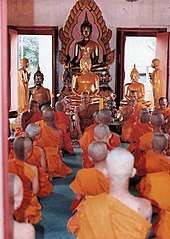
The minimum age for ordaining as a Buddhist monk is 20 years, reckoned from conception. However, boys under that age are allowed to ordain as novices (sāmaṇera), performing a ceremony such as shinbyu in Myanmar. Novices shave their heads, wear the yellow robes, and observe the Ten Precepts. Although no specific minimum age for novices is mentioned in the scriptures, traditionally boys as young as seven are accepted. This tradition follows the story of the Buddha's son, Rahula, who was allowed to become a novice at the age of seven. Monks follow 227 rules of discipline, while nuns follow 311 rules.
In most Theravāda countries, it is a common practice for young men to ordain as monks for a fixed period of time. In Thailand and Myanmar, young men typically ordain for the retreat during Vassa, the three-month monsoon season, though shorter or longer periods of ordination are not rare. Traditionally, temporary ordination was even more flexible among Laotians. Once they had undergone their initial ordination as young men, Laotian men were permitted to temporarily ordain again at any time, though married men were expected to seek their wife's permission. Throughout Southeast Asia, there is little stigma attached to leaving the monastic life. Monks regularly leave the robes after acquiring an education, or when compelled by family obligations or ill health.
Ordaining as a monk, even for a short period, is seen as having many virtues. In many Southeast Asian cultures, it is seen as a means for a young man to "repay" his parents for their work and effort in raising him, because the merit from his ordination accrues to them as well. Thai men who have ordained as a monk may be seen as more fit husbands by Thai women, who refer to men who have served as monks with a colloquial term meaning "ripe" to indicate that they are more mature and ready for marriage. Particularly in rural areas, temporary ordination of boys and young men traditionally gave peasant boys an opportunity to gain an education in temple schools without committing to a permanent monastic life.
In Sri Lanka, temporary ordination is not practised, and a monk leaving the order is frowned upon. The continuing influence of the caste system in Sri Lanka plays a role in the taboo against temporary or permanent ordination as a bhikkhu in some orders. Though Sri Lankan orders are often organized along caste lines, men who ordain as monks temporarily pass outside of the conventional caste system, and as such during their time as monks may act (or be treated) in a way that would not be in line with the expected duties and privileges of their caste.
Men and women born in Western countries, who become Buddhists as adults, wish to become monks or nuns. It is possible, and one can live as a monk or nun in the country they were born in, seek monks or nuns which has gathered in a different Western country or move to a monastery in countries like Sri Lanka or Thailand. It is seen as being easier to live a life as a monk or nun in countries where people generally live by the culture of Buddhism, since it is difficult to live by the rules of a monk or a nun in a Western country. For instance, a Theravāda monk or nun is not allowed to work, handle money, listen to music, cook and so on, which are extremely difficult rules to live by in cultures which do not embrace Buddhism.
Some of the more well-known Theravādan monks are Mun Bhuridatta, Ajahn Chah, Ledi Sayadaw, Webu Sayadaw, Ajahn Plien Panyapatipo, Ajahn Sumedho, Ajahn Khemadhammo, Ajahn Brahm, Bhikkhu Bodhi, Buddhadasa, Mahasi Sayadaw, Nyanaponika Thera, Preah Maha Ghosananda, U Pandita, Ajahn Amaro, Ajahn Sucitto, Thanissaro Bhikkhu, Walpola Rahula, Henepola Gunaratana, Bhante Yogavacara Rahula and Luang Pu Sodh Candasaro.
Monastic practices
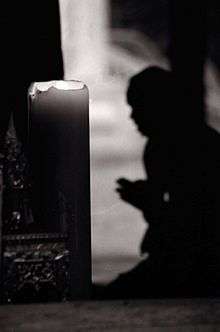
The practices usually vary in different sub-schools and monasteries within Theravāda. But in the most orthodox forest monastery, the monk usually models his practice and lifestyle on that of the Buddha and his first generation of disciples by living close to nature in forest, mountains and caves. Forest monasteries still keep alive the ancient traditions through following the Buddhist monastic code of discipline in all its detail and developing meditation in secluded forests.
In a typical daily routine at the monastery during the 3 month vassa period, the monk will wake up before dawn and will begin the day with group chanting and meditation. At dawn the monks will go out to surrounding villages bare-footed on alms-round and will have the only meal of the day before noon by eating from the bowl by hand. Most of the time is spent on Dhamma study and meditation. Sometimes the abbot or a senior monk will give a Dhamma talk to the visitors. Laity who stay at the monastery will have to abide by the traditional eight Buddhist precepts.
The life of the monk or nun in a community is much more complex than the life of the forest monk. In the Buddhist society of Sri Lanka, most monks spend hours every day in taking care of the needs of lay people such as preaching bana,[182] accepting alms, officiating funerals, teaching dhamma to adults and children in addition to providing social services to the community.
After the end of the Vassa period, many of the monks will go out far away from the monastery to find a remote place (usually in the forest) where they can hang their umbrella tents and where it is suitable for the work of self-development. When they go wandering, they walk barefoot, and go wherever they feel inclined. Only those requisites which are necessary will be carried along. These generally consist of the bowl, the three robes, a bathing cloth, an umbrella tent, a mosquito net, a kettle of water, a water filter, razor, sandals, some small candles, and a candle lantern.
The monks do not fix their times for walking and sitting meditation, for as soon as they are free they just start doing it; nor do they determine for how long they will go on to meditate. Some of them sometimes walk from dusk to dawn whereas at other times they may walk from between two and seven hours. Some may decide to fast for days or stay at dangerous places where ferocious animals live in order to aid their meditation.
Those monks who have been able to achieve a high level of attainment will be able to guide the junior monks and lay Buddhists toward the four degrees of spiritual attainment.
Bhikkunis
A few years after the arrival of Mahinda, the bhikkhu Saṅghamittā, who is also believed to have been the daughter of Ashoka, came to Sri Lanka. She ordained the first nuns in Sri Lanka. In 429, by request of China's emperor, nuns from Anuradhapura were sent to China to establish the order there, which subsequently spread across East Asia. The prātimokṣa of the nun's order in East Asian Buddhism is the Dharmaguptaka, which is different than the prātimokṣa of the current Theravāda school; the specific ordination of the early Sangha in Sri Lanka not known, although the Dharmaguptaka sect originated with the Sthāvirīya as well.
The nun's order subsequently died out in Sri Lanka in the 11th century and in Burma in the 13th century. It had already died out around the 10th century in other Theravādin areas. Novice ordination has also disappeared in those countries. Therefore, women who wish to live as renunciates in those countries must do so by taking eight or ten precepts. Neither laywomen nor formally ordained, these women do not receive the recognition, education, financial support or status enjoyed by Buddhist men in their countries. These "precept-holders" live in Myanmar, Cambodia, Laos, Nepal, and Thailand. In particular, the governing council of Burmese Buddhism has ruled that there can be no valid ordination of women in modern times, though some Burmese monks disagree. Japan is a special case as, although it has neither the bhikkhuni nor novice ordinations, the precept-holding nuns who live there do enjoy a higher status and better education than their precept-holder sisters elsewhere, and can even become Zen priests.[183] In Tibet there is currently no bhikkhuni ordination, but the Dalai Lama has authorized followers of the Tibetan tradition to be ordained as nuns in traditions that have such ordination.
In 1996, 11 selected Sri Lankan women were ordained fully as Theravāda bhikkhunis by a team of Theravāda monks in concert with a team of Korean nuns in India. There is disagreement among Theravāda vinaya authorities as to whether such ordinations are valid. The Dambulla chapter of the Siam Nikaya in Sri Lanka also carried out a nun's ordination at this time, specifically stating their ordination process was a valid Theravādin process where the other ordination session was not.[184] This chapter has carried out ordination ceremonies for hundreds of nuns since then. This has been criticized by leading figures in the Siam Nikaya and Amarapura Nikaya, and the governing council of Buddhism in Myanmar has declared that there can be no valid ordination of nuns in modern times, though some Burmese monks disagree with this.[185]
In 1997 Dhamma Cetiya Vihara in Boston was founded by Ven. Gotami of Thailand, then a 10 precept nun; when she received full ordination in 2000, her dwelling became America's first Theravāda Buddhist bhikkhuni vihara.
A 55-year-old Thai Buddhist 8-precept white-robed maechee nun, Varanggana Vanavichayen, became the first woman to receive the going-forth ceremony of a novice (and the gold robe) in Thailand, in 2002.[186] On February 28, 2003, Dhammananda Bhikkhuni, formerly known as Chatsumarn Kabilsingh, became the first Thai woman to receive bhikkhuni ordination as a Theravāda nun.[187] Dhammananda Bhikkhuni was ordained in Sri Lanka.[188] The Thai Senate has reviewed and revoked the secular law passed in 1928 banning women's full ordination in Buddhism as unconstitutional for being counter to laws protecting freedom of religion. However Thailand's two main Theravāda Buddhist orders, the Mahanikaya and Dhammayutika Nikaya, have yet to officially accept fully ordained women into their ranks.
In 2009 in Australia four women received bhikkhuni ordination as Theravāda nuns, the first time such ordination had occurred in Australia.[189] It was performed in Perth, Australia, on 22 October 2009 at Bodhinyana Monastery. Abbess Vayama together with Venerables Nirodha, Seri, and Hasapanna were ordained as Bhikkhunis by a dual Sangha act of Bhikkhus and Bhikkhunis in full accordance with the Pāli Vinaya.[190]
In 2010, in the US, four novice nuns were given the full bhikkhuni ordination in the Thai Theravāda tradition, which included the double ordination ceremony. Henepola Gunaratana and other monks and nuns were in attendance. It was the first such ordination ever in the Western hemisphere.[191]
The first bhikkhuni ordination in Germany, the ordination of German woman Samaneri Dhira, occurred on June 21, 2015 at Anenja Vihara.[192]
In Indonesia, the first Theravāda ordination of bhikkhunis in Indonesia after more than a thousand years occurred in 2015 at Wisma Kusalayani in Lembang, Bandung in West Java.[193] Those ordained included Vajiradevi Sadhika Bhikkhuni from Indonesia, Medha Bhikkhuni from Sri Lanka, Anula Bhikkhuni from Japan, Santasukha Santamana Bhikkhuni from Vietnam, Sukhi Bhikkhuni and Sumangala Bhikkhuni from Malaysia, and Jenti Bhikkhuni from Australia.[193]
Monastic orders within Theravāda
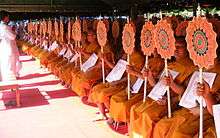
Theravāda monks typically belong to a particular nikaya, variously referred to as monastic orders or fraternities. These different orders do not typically develop separate doctrines, but may differ in the manner in which they observe monastic rules. These monastic orders represent lineages of ordination, typically tracing their origin to a particular group of monks that established a new ordination tradition within a particular country or geographic area.
In Sri Lanka caste plays a major role in the division into nikayas. Some Theravāda Buddhist countries appoint or elect a sangharaja, or Supreme Patriarch of the Sangha, as the highest ranking or seniormost monk in a particular area, or from a particular nikaya. The demise of monarchies has resulted in the suspension of these posts in some countries, but patriarchs have continued to be appointed in Thailand. Myanmar and Cambodia ended the practice of appointing a sangharaja for some time, but the position was later restored, though in Cambodia it lapsed again.
- Bangladesh:
- Myanmar (Myanmar):
- Thudhamma Nikaya
- Shwekyin Nikaya
- Hngettwin Nikaya
- Dwara Nikaya
- Sri Lanka:
- Siam Nikaya
- Rohana
- Malwaththa
- Asgiriya
- Waturawila (or Mahavihara Vamshika Shyamopali Vanavasa Nikaya)
- Amarapura Nikaya has many Sub orders including
- Dharmarakshitha
- Kanduboda (or Swejin Nikaya)
- Tapovana (or Kalyanavamsa)
- Ramañña Nikaya
- Sri Kalyani Yogasrama Samstha (or 'Galduwa Tradition')
- Delduwa
- Siam Nikaya
- Thailand and Cambodia
Festivals and customs
- Magha Puja
- Vesakha Puja
- Asalha Puja
- Uposatha
- Vassa (Rain Retreat)
Demographics
| Rank | Country | Population | Buddhist % | Buddhist total | Importance of religion |
|---|---|---|---|---|---|
| 1 | 66,720,153[web 14] | 95%[web 15] | 63,117,265 | 97%[web 16] | |
| 2 | 56,280,000[web 17] | 89%[web 18] | 50,649,200 | 96%[web 16] | |
| 3 | 20,277,597 | 70% | 14,222,844 | 100%[web 16] | |
| 4 | 14,701,717[web 19] | 98%[web 19] | 14,172,455 | 95%[web 16] | |
| 5 | 6,477,211[web 20] | 67%[web 20] | 4,339,731 | 98%[web 16] |
Theravāda Buddhism is practiced in the following countries and by people worldwide:
- In South Asia:
- Nepal
- Sri Lanka (by 70% of the population)
- Bangladesh (by 2% of the population) mainly in Chittagong Hill Tracts and Kuwakata,Barishal
- India, traditional Theravāda mainly in the Seven Sister States
- In Southeast Asia:
- Cambodia (by 98% of the population)
- Laos (by 67% of the population)
- Myanmar (by 89% of the population)
- Thailand (by 90% of the population, 94% of the population that practices religion)
- Vietnam (by the Khmer Krom in the south and central parts of Vietnam and Tai Dam in northern Vietnam)
- Malaysia (in peninsular Malaysia especially north-western parts of Malaysia, primarily by the Malaysian Siamese and Malaysian Sinhalese)
- Indonesia
- Singapore
- In East Asia:
- Theravāda has also recently gained popularity in the Western world.
Today, Theravādins number over 150 million worldwide, and during the past few decades Theravāda Buddhism has begun to take root in the West[lower-alpha 2] and in the Buddhist revival in India.[web 22]
See also
- Buddhahood
- Buddhism in China
- Buddhist pilgrimage
- Supreme Patriarch of Thailand
Notes
- Source says,"Technical terms from Sanskrit were converted into Pali by a set of conventional phonological transformations". Vowels and diphthongs from Sanskrit to Pali follow this pattern. Thus 'Sthavira' in Sanskrit becomes 'Thera' in Pali. Sanskrit 'avi' becomes Pali 'e' (i.e. Sthavira → ai → Thera).
- John Bullit: "In the last century, however, the West has begun to take notice of Theravāda's unique spiritual legacy and teachings of Awakening. In recent decades, this interest has swelled, with the monastic Sangha from the schools within Theravāda, establishing dozens of monasteries across Europe and North America."[web 21]
References
- Gyatso, Tenzin (2005). Bodhi, Bhikkhu (ed.). In the Buddha's Words: An Anthology of Discourses from the Pali Canon. Somerville, Massachusetts: Wisdom Publications. p. ix. ISBN 978-0-86171-491-9.
- Reynolds, Frank E.; Kitagawa, Joseph M.; Nakamura, Hajime; Lopez, Donald S.; Tucci, Giuseppe (2018). "Theravada". britannica.com. Encyclopaedia Britannica.
Theravada (Pali: “Way of the Elders”; Sanskrit, Sthaviravada) emerged as one of the Hinayana (Sanskrit: “Lesser Vehicle”) schools, traditionally numbered at 18, of early Buddhism. The Theravadins trace their lineage to the Sthaviravada school, one of the two major schools (the Mahasanghika was the other) that supposedly formed in the wake of the Council of Vaishali (now in Bihar state) held some 100 years after the Buddha’s death. Employing Pali as their sacred language, the Theravadins preserved their version of the Buddha’s teaching in the Tipitaka (“Three Baskets”).
- Crosby, Kate (2013), Theravada Buddhism: Continuity, Diversity, and Identity, p. 2.
- Gombrich, Richard (2006), Theravada Buddhism: A Social History from Ancient Benares to Modern Colombo, Routledge; 2nd edition, p. 37.
- Prebish, Charles S. (1975). Buddhism – a modern perspective. University Park: Pennsylvania State University Press. ISBN 0271011858. OCLC 1103133.
- Skilton, Andrew. A Concise History of Buddhism. 2004. pp. 49, 64
- Cousins, Lance (2001). "On the Vibhajjavādins", Buddhist Studies Review 18 (2), 131–182
- Keown, Damien. A Dictionary of Buddhism. 2003. ISBN 0-19-860560-9. pp. 279–280
- Hirakawa Akira (translated and edited by Paul Groner), A History Of India Buddhism, Motilal Banarsidass Publishers, Delhi, 1993, p. 109.
- Crosby, Kate (2013), Theravada Buddhism: Continuity, Diversity, and Identity, Wiley-Blackwell, pp. 1–3, ISBN 978-1405189071
- Cousins, LS. On the Vibhajjavadins. The Mahimsasaka, Dhammaguttaka, Kassapiya and Tambapanniya branches of the ancient Theriyas, Buddhist Studies Review 18, 2 (2001).
- Warder 2000, p. 278.
- Bandaranayake, S.D. Sinhalese Monastic Architecture: The Viháras of Anurádhapura, p. 22
- Samuel Beal, "Si-Yu-Ki – Buddhist Records of the Western World – Translated from the Chinese of Hiuen Tsiang AD 629", published by Tuebner and Co, London (1884), reprint by the Oriental Book Reprint Corporation, New Delhi (1983), Digital version: Chung-hwa Institute of Buddhist Studies, Taipei.
- Samuel Beal, "The Life of Hiuen-Tsiang: By the Shaman Hwui Li. With an introduction containing an account of the works of I-tsing", published by Tuebner and Co, London (1911), Digital version: University of Michigan.
- It is used in the Dipavamsa (quoted in Debates Commentary, Pali Text society, p. 4), which is generally dated to the 4th century.
- Bandaranayake, S.D. Sinhalese Monastic Architecture: The Viháras of Anurádhapura, p. 25
- Gombrich, Theravada Buddhism, a social history from Ancient Benares to Modern Colombo, Routledge; 2 edition (2006), p. 152
- Pollock, Sheldon I. Literary Cultures in History: Reconstructions from South Asia, p. 650
- Gombrich, Theravada Buddhism, a social history from Ancient Benares to Modern Colombo, Routledge; 2 edition (2006), p. 153
- Law, A history of Pali literature, 349.
- Gombrich, Theravada Buddhism, a social history from Ancient Benares to Modern Colombo, Routledge; 2 edition (2006), p. 154
- Warder, A.K. Indian Buddhism. 2000. p. 280
- Hirakawa, Akira; Groner, Paul. A History of Indian Buddhism: From Śākyamuni to Early Mahāyāna. 2007. p. 121
- "Importance of Mahavihara as the centre of Theravada Buddhism.doc – Bhikkhu – Sri Lanka". Scribd.
- Hirakawa, Akira. Groner, Paul. A History of Indian Buddhism: From Śākyamuni to Early Mahāyāna. 2007. p. 124
- Gombrich, Richard Francis. Theravāda Buddhism: A Social History. 1988. p. 158
- Baruah, Bibhuti. Buddhist Sects and Sectarianism. 2008. p. 53
- Hoiberg, Dale H., ed. (2010). "Abhayagiri". Encyclopædia Britannica. I: A–ak Bayes (15th ed.). Chicago, Illinois: Encyclopædia Britannica Inc. p. 30. ISBN 978-1-59339-837-8.
- Rangama, Chandawimala;The impact of the Abhayagiri practices on the development of Theravada Buddhism in Sri Lanka, 2007
- Hirakawa, Akira. Groner, Paul. A History of Indian Buddhism: From Śākyamuni to Early Mahāyāna. 2007. p. 257
- Kalupahana 1994, pp. 206–208.
- Hirakawa, Akira. Groner, Paul. A History of Indian Buddhism: From Śākyamuni to Early Mahāyāna. 2007. pp. 125–126
- "Esoteric Buddhism in Southeast Asia in the Light of Recent Scholarship" by Hiram Woodward. Journal of Southeast Asian Studies, Vol. 35, No. 2 (June 2004), p. 341
- Hirakawa, Akira; Groner, Paul (1993). A History of Indian Buddhism: From Śākyamuni to Early Mahāyāna. Motilal Banarsidass. p. 126. ISBN 978-81-208-0955-0.
- Queen, Christopher S.; Williams, Duncan Ryuken (2013). American Buddhism: Methods and Findings in Recent Scholarship. Routledge. p. 134. ISBN 978-1-136-83033-4.
- Gombrich, Richard. Theravāda Buddhism: A Social History From Ancient Benares to Modern Colombo. 1988. p. 159
- Gombrich, Richard. Theravāda Buddhism: A Social History from Ancient Benares to Modern Colombo. 1988. p. 159
- Paranavitana, History of Ceylon, p. 215
- Sujato, Bhante (2012), Sects & Sectarianism: The Origins of Buddhist Schools, Santipada, p. 69, ISBN 978-1921842085
- Culavamsa, LXXVIII, 1–3
- Culavamsa, LXXVIII, 7
- Perera, HR; Buddhism in Sri Lanka A Short History, Buddhist Publication Society, Kandy, Sri Lanka, page
- Mahavamsa: The great chronicle of Ceylon tr. Wilhelm Geiger. Pali Text Society, 1912, pp. 82, 86
- Frasch, Tilman. "The Theravaada Buddhist Ecumene in the Fifteenth Century: Intellectual Foundations and Material Representations" in Buddhism Across Asia, Networks of Material, Intellectual and Cultural Exchange, Volume 1 – Institute of Southeast Asian Studies (2014), p. 347.
- Sujato, Bhante (2012), Sects & Sectarianism: The Origins of Buddhist Schools, Santipada, p. 72, ISBN 978-1921842085
- Baruah, Bibhuti. Buddhist Sects and Sectarianism. 2008. p. 131
- Frasch, Tilman; p. 350.
- Smith, Huston & Novak, Philip. Buddhism: A Concise Introduction. New York: HarperCollins Publishers, 2003
- Gombrich, Richard Francis. Theravāda Buddhism: A Social History. 1988. p. 137
- Gombrich, Richard Francis. Theravāda Buddhism: A Social History. 1988. p. 3
- Professor Janice Stargardt. "Historical Geography of Burma: Creation of enduring patterns in the Pyu period". IIAS Newsletter Online, No 25, Theme Burmese Heritage.
- Skilling, Peter. The Advent of Theravada Buddhism to Mainland South-east Asia.
- Lieberman, Victor B (2003). Strange Parallels: Southeast Asia in Global Context, c. 800–1830, Volume 1: Integration on the Mainland. Cambridge University Press. pp. 115–116. ISBN 978-0-521-80496-7.
- Keyes, 1995, pp. 78–82
- Gyallay-Pap, Peter. "Notes of the Rebirth of Khmer Buddhism", Radical Conservativism.
- Prapod Assavavirulhakarn. The Ascendancy of Theravada Buddhism in Southeast Asia. Chiang Mai: Silkworm Books, 2010.
- Cousins, L.S. (1997), "Aspects of Southern Esoteric Buddhism"
- Cousins, L.S. (1997), "Aspects of Southern Esoteric Buddhism", in Peter Connolly and Sue Hamilton (eds.), Indian Insights: Buddhism, Brahmanism and Bhakd Papers from the Annual Spalding Symposium on Indian Religions, Luzac Oriental, London: 185–207, 410. ISBN 1-898942-153
- Crosby, Kate (2000). "Tantric Theravada: A Bibliographic Essay on the Writings of Francois Bizot and others on the Yogavacara-Tradition", Contemporary Buddhism 1 (2), 141–198
- McMahan 2008.
- Wilson 2014.
- Edmund F. Perry's introduction to Walpola Rahula's The Heritage of the Bhikkhu: A Short History of the Bhikkhu in the Educational, Cultural, Social, and Political Life. Grove Press, New York, 1974, p. xii.
- Stanley Jeyaraja Tambiah, Buddhism Betrayed? The University of Chicago Press, 1992, pp. 35–36.
- Stanley Jeyaraja Tambiah, Buddhism Betrayed? The University of Chicago Press, 1992, p. 28.
- Stanley Jeyaraja Tambiah, Buddhism Betrayed? The University of Chicago Press, 1992, p. 29.
- Stanley Jeyaraja Tambiah, Buddhism Betrayed? The University of Chicago Press, 1992, pp. 63–64.
- "Buddhism in Sri Lanka", Wikipedia, 2019-07-07, retrieved 2019-07-18
- Gombrich 1996, pp. 177–181.
- Gombrich 1996, pp. 172–197.
- Swearer, Donald K. The Buddhist World of Southeast Asia: Second Edition, p. 161.
- Braun 2018.
- "Vipassana Meditation". www.dhamma.org. Retrieved 2017-05-31.
- Swearer, Donald K. The Buddhist World of Southeast Asia: Second Edition, p. 162.
- Swearer, Donald K. The Buddhist World of Southeast Asia: Second Edition, p. 163.
- Tiyavanich 1997.
- Harris, Ian (August 2001), "Sangha Groupings in Cambodia", Buddhist Studies Review, UK Association for Buddhist Studies, 18 (I): 65–72
- (Harris 2001, p. 74)
- Indian Insights, ed. Connolly & Hamilton, Luzac, London, 1997, pp. 187–189
- Swearer, Donald K. The Buddhist World of Southeast Asia: Second Edition, p. 155.
- Journal of the International Association of Buddhist Studies, volume 28 (part 2), p. 302 (2005)
- Swearer, Donald K. The Buddhist World of Southeast Asia: Second Edition, p. 134.
- Crosby, 2013, p. 1.
- Harvey, Introduction to Buddhism, Cambridge University Press, 1990, p. 3.
- Peter Harvey, The Selfless Mind. Curzon Press, 1995, p. 9.
- Crosby, 2013, p. 175.
- Dutt 1998, pp. 211–217.
- Warder 2000, p. 217.
- Crosby, 2013, 86.
- Warder 2000, p. 288.
- Ronkin, Noa, Early Buddhist Metaphysics: The Making of a Philosophical Tradition (Routledge curzon Critical Studies in Buddhism) 2011, p. 5.
- James P. McDermott, Encyclopedia of Indian Philosophies, Volume VII: Abhidharma Buddhism to 150 A.D. p. 80.
- "Abhidhamma Pitaka." Encyclopædia Britannica. Ultimate Reference Suite. Chicago: Encyclopædia Britannica, 2008.
- Ronkin, Noa, Early Buddhist Metaphysics: The Making of a Philosophical Tradition (Routledge curzon Critical Studies in Buddhism) 2011, pp. 27–30.
- Frauwallner, Erich. Kidd, Sophie Francis (translator). Steinkellner, Ernst (editor). Studies in Abhidharma Literature and the Origins of Buddhist Philosophical Systems. SUNY Press. pp. 18, 100.
- Crosby, 2013, p. 86.
- Crosby, 2013, p. 71.
- Crosby, 2013, p. 91.
- Crosby, 2013, p. 109.
- Macmillan Encyclopedia of Buddhism, 2004 (Volume Two), p. 756
- Bodhi, In the Buddha's words, p 13
- Ronkin, Noa; Early Buddhist Metaphysics, p. 42.
- Y. Karunadasa, The Dhamma Theory Philosophical Cornerstone of the Abhidhamma, Buddhist Publication Society Kandy, Sri Lanka
- Ronkin, Noa, Early Buddhist Metaphysics: The Making of a Philosophical Tradition (Routledge curzon Critical Studies in Buddhism) 2011, p. 2.
- Potter, Buswell, Jaini; Encyclopedia of Indian Philosophies Volume VII Abhidharma Buddhism to 150 AD, p. 121.
- Karunadasa, Y. Buddhist Analysis of Matter, p. 14.
- Ronkin, Noa; Early Buddhist Metaphysics, p. 41.
- Crosby, 2013, 182.
- Ronkin, Noa; Early Buddhist Metaphysics, p. 92.
- Ronkin, Noa; Early Buddhist Metaphysics, p. 77.
- Ronkin, Noa; Early Buddhist Metaphysics, p. 118.
- Ronkin, Noa; Early Buddhist Metaphysics, p. 47.
- Crosby, 2013, 187.
- James P. McDermott. Encyclopedia of Indian Philosophies, Volume VII: Abhidharma Buddhism to 150 A.D, see entry on the Kathavatthu.
- Warder 2000, p. 283.
- James P. McDermott, Kathavatthu: Encyclopedia of Indian Philosophies, Volume VII: Abhidharma Buddhism to 150 A.D.
- James P. McDermott, Encyclopedia of Indian Philosophies, Volume VII: Abhidharma Buddhism to 150 A.D. p. 95
- Wayman, Alex, Buddhist Insight: Essays, Motilal Banarsidass Publ., 1984 p. 252
- Skilling, Peter. “Scriptural Authenticity and the Śrāvaka Schools: An Essay towards an Indian Perspective.” The Eastern Buddhist, vol. 41, no. 2, 2010, pp. 1–47. JSTOR, www.jstor.org/stable/44362554. Accessed 25 Feb. 2020.
- Karen Pechilis, Selva J. Raj (2013). South Asian Religions: Tradition and Today, p. 115. Routledge.
- Swearer, Donald K. The Buddhist World of Southeast Asia: Second Edition, p. 164.
- McMahan, David L. 2008. The Making of Buddhist Modernism. Oxford: Oxford University Press. pp. 91–97.
- "The Pali Text Society's Pali-English dictionary". Dsal.uchicago.edu. Archived from the original on 2012-07-08. Retrieved 2012-08-17.
- Crosby, 2013, p. 113.
- Crosby, 2013, p. 116.
- Crosby, 2013, 118–119.
- Crosby, 2013, p. 138.
- Crosby, 2013, 139–140.
- Vajiranāṇa Mahathera (author), Allan R. Bomhard (editor) (20100, Buddhist Meditation in Theory and Practice, p. 270.
- Henepola Gunaratana, The Jhanas in Theravada Buddhist Meditation, 1995.
- Polak 2011.
- Nyanaponika, The Heart of Buddhist meditation, Buddhist publication Society, 2005, p. 40.
- Fronsdal 1998.
- Crosby, 2013, p. 149.
- Wilson 2014, pp. 54–55.
- Mahāsi Sayādaw, Manual of Insight, Chapter 5
- Majjhima Nikaya, Sutta No. 118, Section No. 2, translated from the Pali
- Satipatthana Sutta
- Mahasi Sayadaw, Practical Vipassana Instructions
- Bhante Bodhidhamma, Vipassana as taught by The Mahasi Sayadaw of Burma
- "The Art of Living: Vipassana Meditation". Dhamma.org. Retrieved 2013-05-30.
- Mahasi Sayadaw, Practical Vipassana Instructions, pp. 22–27
- PVI, p. 28
- Nyanaponika 1998.
- Gombrich 1997, p. 133.
- Gethin, Rupert, The Foundations of Buddhism, Oxford University Press, p. 234.
- Crosby, 2013, p. 156.
- Shaw, Sarah. "Buddhist Meditation Practices in the West" (PDF). Department of Continuing Education, Oxford University. p. 8. Archived from the original (PDF) on 2011-07-04. Retrieved 2009-03-27.
- Buddhaghosa & Nanamoli (1999), pp. 90–91 (II, 27–28, "Development in Brief"), 110ff. (starting with III, 104, "enumeration"). It can also be found sprinkled earlier in this text as on p. 18 (I, 39, v. 2) and p. 39 (I, 107). Throughout Nanamoli translates this term as "meditation subject."
- Crosby, Kate (2013), Theravada Buddhism: Continuity, Diversity, and Identity, John Wiley & Sons, p. 141.
- Crosby, Kate (2013), Theravada Buddhism: Continuity, Diversity, and Identity, John Wiley & Sons, p. 145.
- Crosby et al. The Sutta on Understanding Death in the Transmission of Bora ̄n Meditation From Siam to the Kandyan Court. J Indian Philos (2012) 40:177–198 doi:10.1007/s10781-011-9151-y
- Andrew Skilton; Phibul ChoomPolPaisal. The Ancient Theravāda Meditation System, Borān Kammaṭṭhāna: Ānāpānasati or ‘Mindfulness of The Breath’ in Kammatthan Majjima Baeb Lamdub. Buddhist Studies Review 0256-2897.
- Crosby, Kate (2013), Theravada Buddhism: Continuity, Diversity, and Identity, John Wiley & Sons, p. 157.
- Buswell 2004, p. 890.
- McMahan 2008, p. 189.
- Buswell 2004, p. 889.
- Crosby, Kate (2013), Theravada Buddhism: Continuity, Diversity, and Identity, John Wiley & Sons, pp. 160, 166.
- Crosby, Kate (2013), Theravada Buddhism: Continuity, Diversity, and Identity, John Wiley & Sons, p. 146.
- Crosby, Kate (2013), Theravada Buddhism: Continuity, Diversity, and Identity, John Wiley & Sons, p. 164.
- Sharf 1995, p. 242.
- Crosby 2013, p. 147.
- Sharf 1995.
- Crosby, 2013, 142.
- Crosby, 2013, p. 157.
- Bhikkhu Khantipalo, Lay Buddhist Practice The Shrine Room, Uposatha Day, Rains Residence
- "Glossary of Buddhism". Buddhist Art and the Trade Routes. Asia Society. 2003. Retrieved 2010-09-17.
- Epstein, Ron (1999). "Clearing Up Some Misconceptions about Buddhism". Vajra Bodhi Sea: A Monthly Journal of Orthodox Buddhism: 41–43.
- Bhikkhu Bodhi, In the Buddha's Words, Wisdom Publications 2005; p. 376
- Swearer, Donald K. The Buddhist World of Southeast Asia: Second Edition, p. 178.
- Swearer, Donald K. The Buddhist World of Southeast Asia: Second Edition, p. 187.
- Taylor, J.L. Forest Monks and the Nation-state: An Anthropological and Historical Study, pp. 12, 15
- Tambiah, Stanley Jeyaraja, The Buddhist Saints of the Forest and the Cult of Amulets (Cambridge Studies in Social and Cultural Anthropology), 1984, p. 55.
- Taylor, J.L. Forest Monks and the Nation-state: An Anthropological and Historical Study, p. 12
- Tambiah, Stanley Jeyaraja, The Buddhist Saints of the Forest and the Cult of Amulets (Cambridge Studies in Social and Cultural Anthropology), 1984, pp. 53, 58
- Prapod Assavavirulhakarn, The Ascendency of Theravada Buddhism in Southeast Asia 1990, p. 258.
- Taylor, J.L. Forest Monks and the Nation-state: An Anthropological and Historical Study, p. 9
- Taylor, J.L. Forest Monks and the Nation-state: An Anthropological and Historical Study, pp. 9–13
- Taylor, J.L. Forest Monks and the Nation-state: An Anthropological and Historical Study, p. 15
- "Pa-Auk Tawya".
- Tiyavanich, Kamala, nForest Recollections: Wandering Monks in Twentieth-Century Thailand p1
- Mahinda Deegalle, Popularizing Buddhism: Preaching as Performance in Sri Lanka, State University of New York Press, Albany, 2006.
- "Resources on Women's Ordination". Lhamo.tripod.com. Retrieved 2010-11-19.
- Salgado 2013, pp. 166–169.
- Kawanami, Hiroko (2007). "The bhikkhunī ordination debate: global aspirations, local concerns, with special emphasis on the views of the monastic community in Myanmar. Kawanami, H. 11/2007 In". Buddhist Studies Review. 24 (2): 226–244. doi:10.1558/bsrv.v24i2.226.
- Sommer, PhD, Jeanne Matthew. "Socially Engaged Buddhism in Thailand: Ordination of Thai Women Monks". Warren Wilson College. Archived from the original on 4 December 2008. Retrieved 6 December 2011.
- "Ordained At Last". Thebuddhadharma.com. 2003-02-28. Archived from the original on 2004-02-06. Retrieved 2010-11-19.
- Rita C. Larivee, SSA (2003-05-14). "Bhikkhunis: Ordaining Buddhist Women". Nationalcatholicreporter.org. Retrieved 2010-11-19.
- "Thai monks oppose West Australian ordination of Buddhist nuns". Wa.buddhistcouncil.org.au. Retrieved 2010-11-19.
- "Bhikkhuni Ordination". Dhammasara.org.au. 2009-10-22. Archived from the original on 2011-02-19. Retrieved 2010-11-19.
- Boorstein, Sylvia (2011-05-25). "Ordination of Bhikkhunis in the Theravada Tradition". Huffington Post.
- Bhikkhuni Happenings – Alliance for Bhikkhunis. Bhikkhuni.net. Retrieved on 2015-06-28.
- http://www.bhikkhuni.net/wp-content/uploads/2015/06/FirstTheravadaordinationofbhikkhunisinIndonesiaAfteraThousandYears.pdf
Sources
Printed sources
- Braun, Eric (2018), The Insight Revolution, Lion's Roar
- last Buswell, Robert, ed. (2004), Encyclopedia of Buddhism, MacMillan
- Crosby, Kate (2013), Theravada Buddhism: Continuity, Diversity, and Identity, Wiley-Blackwell
- Dutt, Nalinaksha (1998), Buddhist Sects in India, Delhi: Motilal Banarsidass Publishers Private Limited
- Gombrich, Richard F. (1996), Theravāda Buddhism. A Social History from Ancient Benares to Modern Colombo, London and New York: Routledge
- Gombrich, Richard F. (1997), How Buddhism Began. The Conditioned Genesis of the Early Teachings, New Delhi: Munshiram Manoharlal Publishers Pvt. Ltd.
- Gomez, Luis O. (1991), Purifying Gold: The Metaphor of Effort and Intuition in Buddhist Thought and Practice. In: Peter N. Gregory (editor)(1991), Sudden and Gradual. Approaches to Enlightenment in Chinese Thought, Delhi: Motilal Banarsidass Publishers Private Limited
- Gunaratana, Henepola (1994), The Path of Serenity and Insight, Delhi: Motilal Banarsidass Publishers Private Limited
- Kalupahana, David J. (1994), A history of Buddhist philosophy, Delhi: Motilal Banarsidass Publishers Private Limited
- McMahan, David L. (2008), The Making of Buddhist Modernism, Oxford University Press, ISBN 9780195183276
- Nyanaponika (1998), Het hart van boeddhistische meditatie (The heart of Buddhist Meditation), Asoka
- Polak, Grzegorz (2011), Reexamining Jhana: Towards a Critical Reconstruction of Early Buddhist Soteriology, UMCS
- Salgado, Nirmala S. (November 2013). Buddhist Nuns and Gendered Practice: In Search of the Female Renunciant. OUP. ISBN 978-0-19-976001-5.CS1 maint: ref=harv (link)
- Tuchrello, William P. (n.d.), The Society and Its Environment. (Religion: Historical Background section), Federal Research Division, Library of Congress
- Tiyavanich, K. (1997), Forest Recollections: Wandering Monks in Twentieth-Century Thailand, University of Hawaii Press
- Warder, A.K. (2000), Indian Buddhism, Delhi: Motilal Banarsidass Publishers
Web sources
- Erik Braun (2014), Meditation en masse. How colonialism sparked the global Vipassana movement
- "Plan your trip to Bagan (Pagan), Myanmar". AsiaExplorers. 2003-11-25. Retrieved 2012-08-17.
- "Modern Theravāda".
- "Magga-vibhanga Sutta: An Analysis of the Path".
- "The Pali Text Society's Pali-English dictionary". Dsal.uchicago.edu. Archived from the original on 2012-07-08. Retrieved 2012-08-17.
- "The Pali Text Society's Pali-English dictionary". Dsal.uchicago.edu. Archived from the original on 2012-07-09. Retrieved 2012-08-17.
- "The Pali Text Society's Pali-English dictionary". Dsal.uchicago.edu. Archived from the original on 2012-07-11. Retrieved 2012-08-17.
- Henepola Gunaratana, The Jhanas in Theravāda Buddhist Meditation
- "A Sketch of the Buddha's Life". Access to Insight. Retrieved 2009-03-26.
- Gunaratana, Henepola (1995). "The Jhanas in Theravada Buddhist Meditation". Access to Insight. Retrieved 13 March 2020.
- "Lohicca Sutta". Access to Insight. Retrieved 2009-03-27.
- S Thanissaro Bhikkhu, Into the Stream A Study Guide on the First Stage of Awakening
- Ajahn Chah, Opening the Dhamma Eye
- "Archived copy" (PDF). Archived from the original (PDF) on 2011-07-16. Retrieved 2011-07-16.CS1 maint: archived copy as title (link)
- "The World Factbook". Cia.gov. Retrieved 2012-08-17.
- Gallup WorldView. data accessed on 2012-09-07
- "Retrieved 8 July 2010" (PDF). Archived from the original (PDF) on 2007-10-24.
- "The World Factbook". Cia.gov. Archived from the original on 2010-12-29. Retrieved 2012-08-17.
- "CIA – The World Factbook". Cia.gov. Retrieved 2012-08-17.
- "CIA – The World Factbook". Cia.gov. Retrieved 2012-08-17.
- Bullitt, John. "What is Theravāda Buddhism?". BuddhaNet. Retrieved 2010-08-15.
- Adherants.com – See the citations under 'Theravāda Buddhism – World'
External links
| Wikimedia Commons has media related to Theravada. |
- Theravada at the Encyclopædia Britannica
- Access to Insight – Readings in Theravāda Buddhism
- The Bodhisattva Ideal in Theravāda Theory and Practice by Jeffrey Samuels
- What are the teachings of Theravada Buddhism? on Tricycle's Buddhism for Beginners Series

